Midterm rubens and rembrandt
1/117
There's no tags or description
Looks like no tags are added yet.
Name | Mastery | Learn | Test | Matching | Spaced |
|---|
No study sessions yet.
118 Terms

Rubens, Adam and Eve, before 1600
Early style, much like Otto Van Veen

Rubens, Laocoon, c. 1600-1606
black chalk with wash and white heightening
study drawing based on classical sculpture
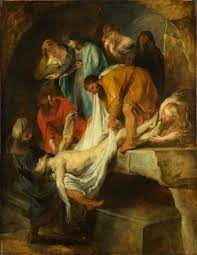
Rubens, entombment of Christ, 1601-02
pose copied from Sistine chapel
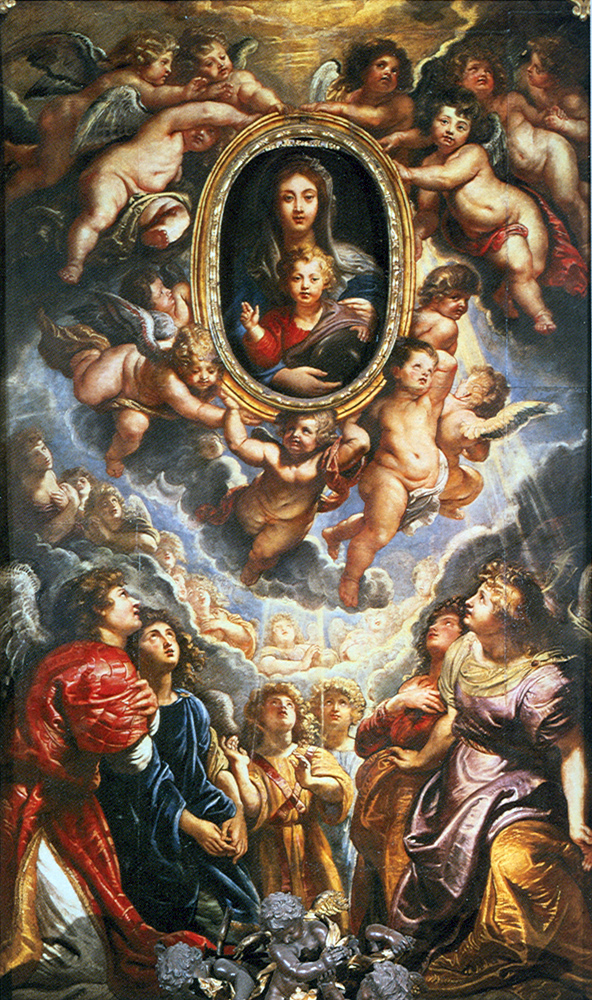
Rubens, the madonna della Vallicella with Six saints, c. 1607-08
big comission for the S. Maria in Vallicella
shows he can compete against the Italians
Christian saints, due to the counter reformation

Rubens, Marchesa Brigida Spinola Doria
Italian noblewoman

Rubens, equestrian portrait of the duke of lerma, 1603
storm clouds, tree around him, become a canopy of honor for the duke
horse is front view instead of side
reformulate this type of portrait

VD, marchesa elena grimaldi, 1623
italian noblewoman
elongated, dramatic, controlled
elegant, graceful
attendant showing a subordinate
mastery of portraiture
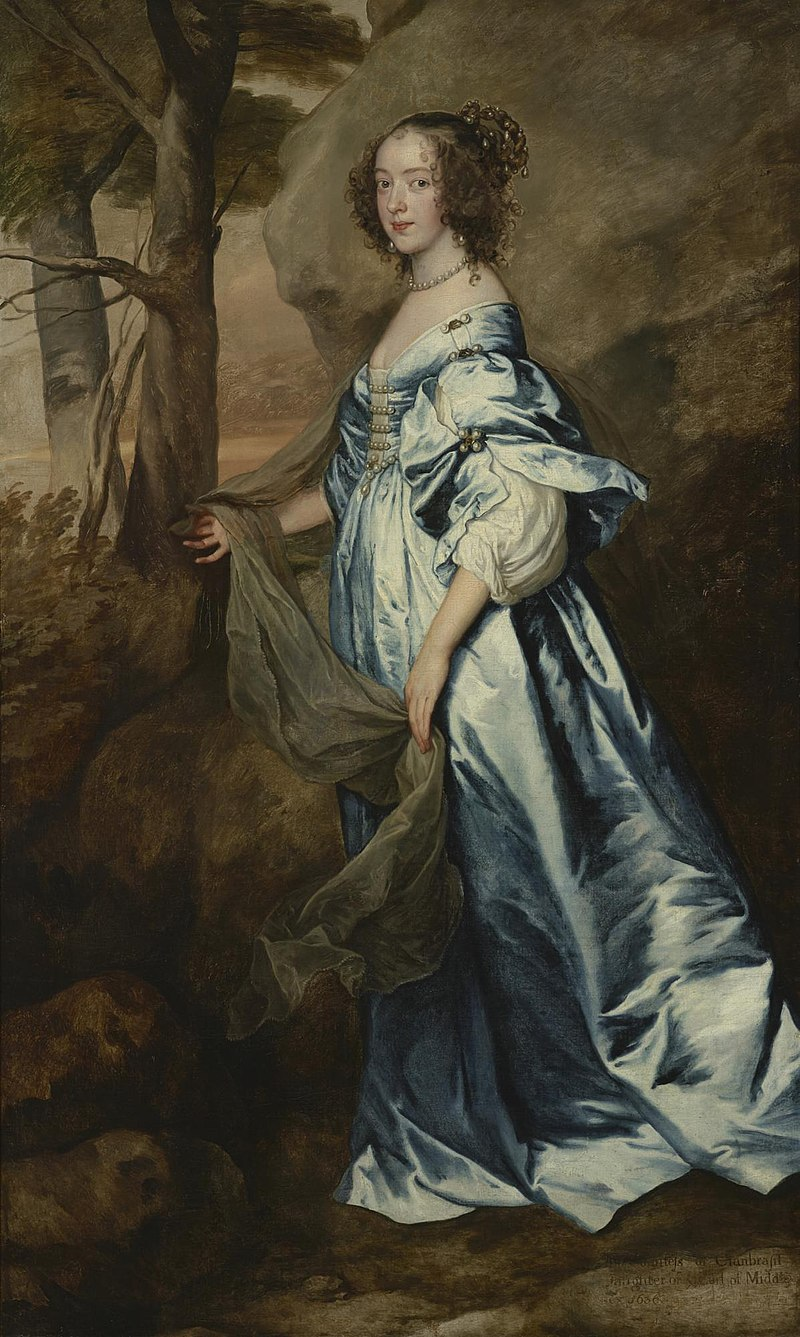
VD, Anne, Countess of Clanbrassil, 1636
noblewoman
less formal, more flowing, more freedom
lacking customary undergarment
clothing wasn’t quite present, may look old fashioned if they wore current clothing
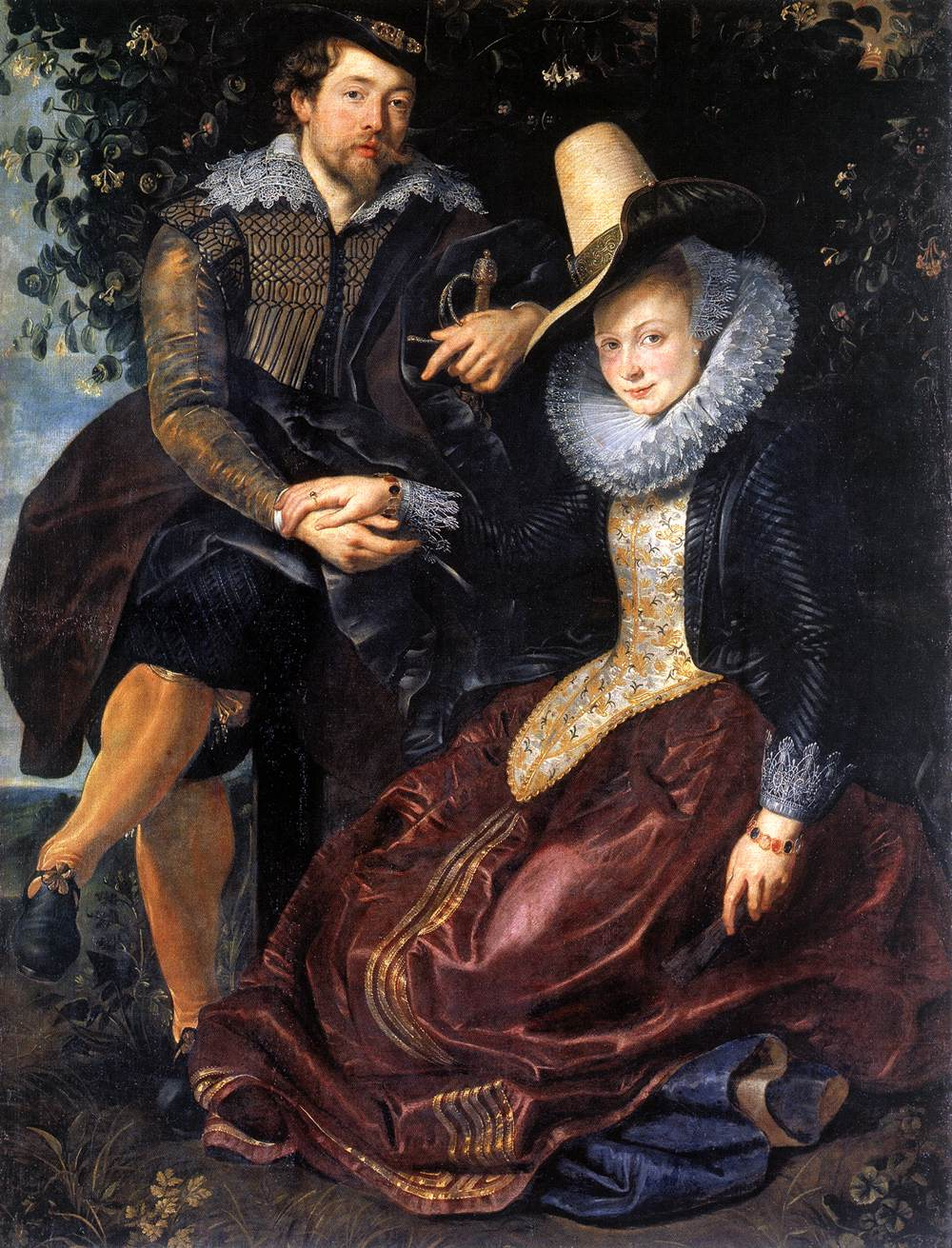
Rubens, self portrait with his wife, isabella brant c. 1609
more informal than usual
he is in the superior position, she is in the inferior position
he is more active and she, more still
quality of clothing emphasizes social status
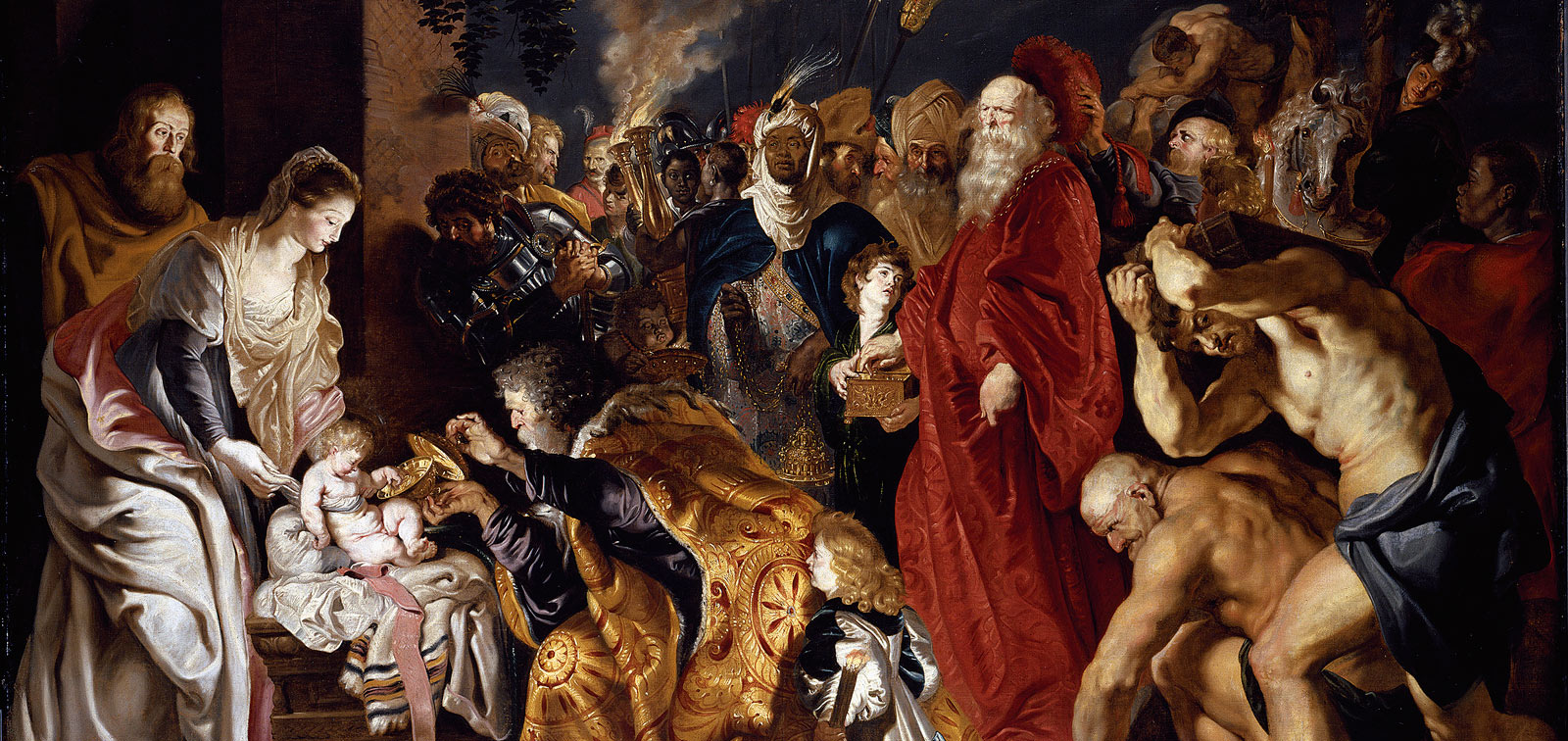
Rubens, The adoration of the magi 1609, later enlarged at right
one wiseman is a different ethnicity, traditional for the time
It’s a night scene but there are several light sources, one of the child
Variety of human beings, men of many ages, ranks, types
This grand, heroic presentation are something that are in a lot of hid painting
There’s a boy blowing coals, he was able to capture the coal reflection and the light on his face
This was an allusion to some other thing
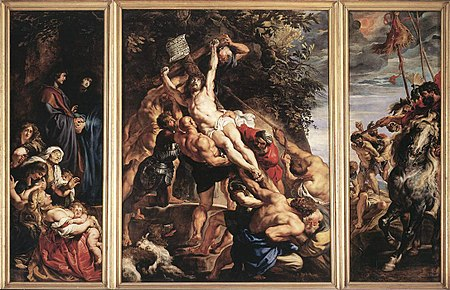
Rubens, The Raising of the Cross Triptych, 1610-11
Big commission, huge painting too
It’s a triptych, three sections, outer wings that can be closed in
This was on an altarpiece, large structure with other smaller paintings on it too, also by rubens
Dominant, diagonal, and subsidiary crossing
Christ more brightly lit
The composition seems to be inspired by another big painting by some italian guy
This kind of highly energized and idealized art was what the counter reformation was about
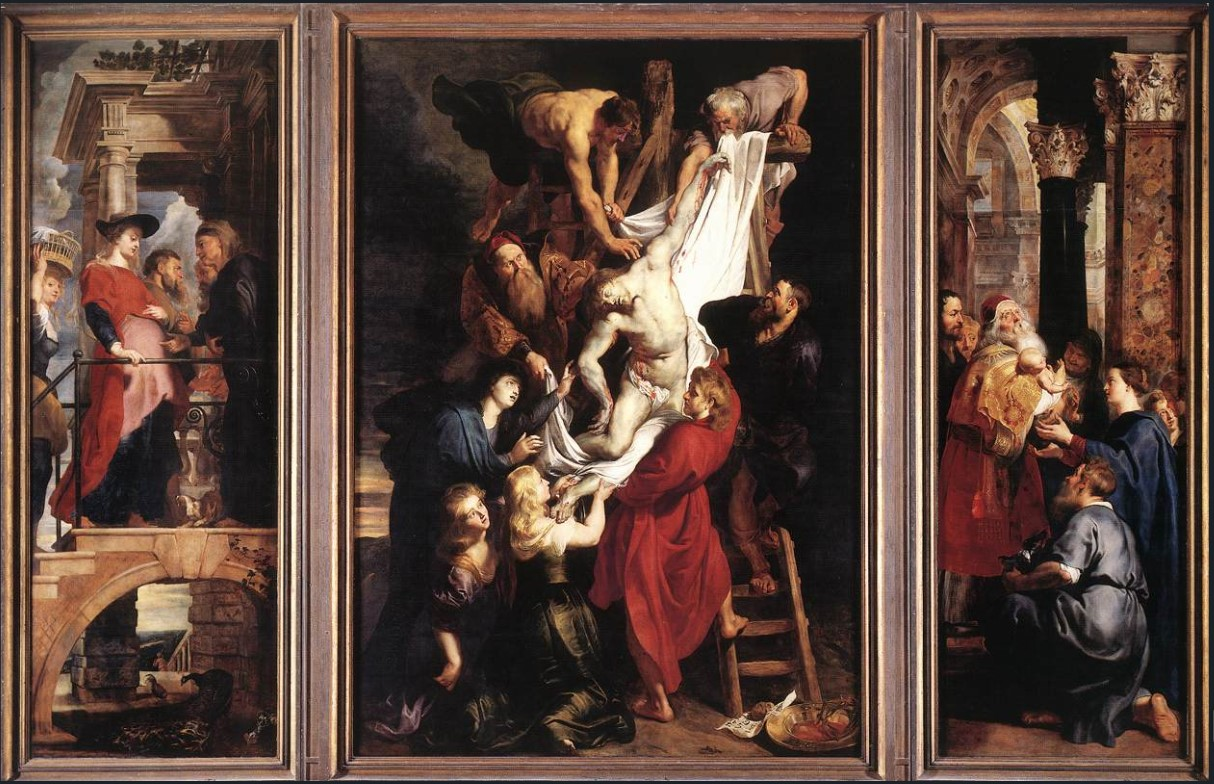
Rubens, the descent from the cross altarpiece, 1611-14
left: visitation
right: presentation of christ in the temple
similar to the other one but more inward, much less exuberant and dynamic
much less hands on
John is receiving the body in cloth
pronated arm, inspired by mike to show actually dead

rubens, samson and delilah 1609
embrace of the body, emotions
work is idealized
big strong features invading our space
male figure big, woman voloptuous, emphasies fricking
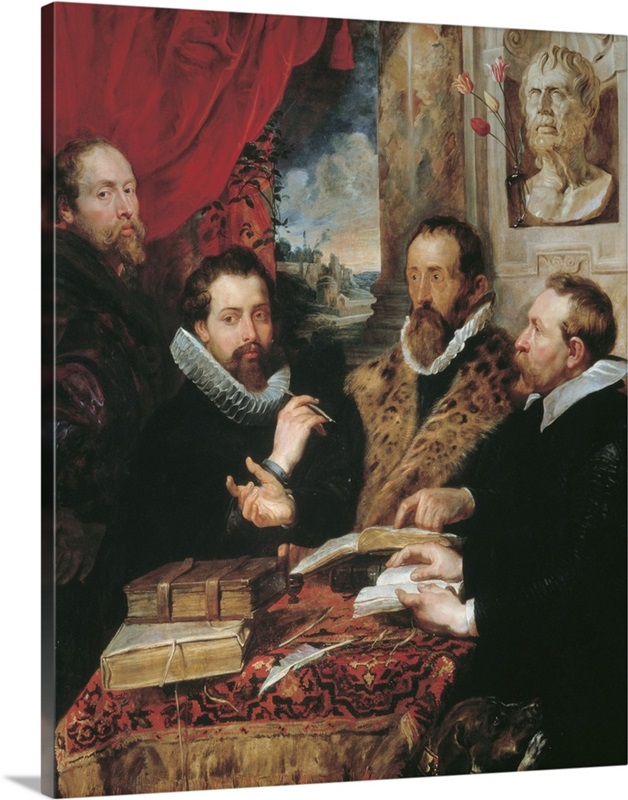
rubens four philosophers, c. 1612-14
rubens, philip rubens, justus lipsius, jan woverius, and lipsius’ dog, mopsulus
showed an intellectual interest
people rubens looked up to
put himself in the background because he didn’t claim himself as a philosopher
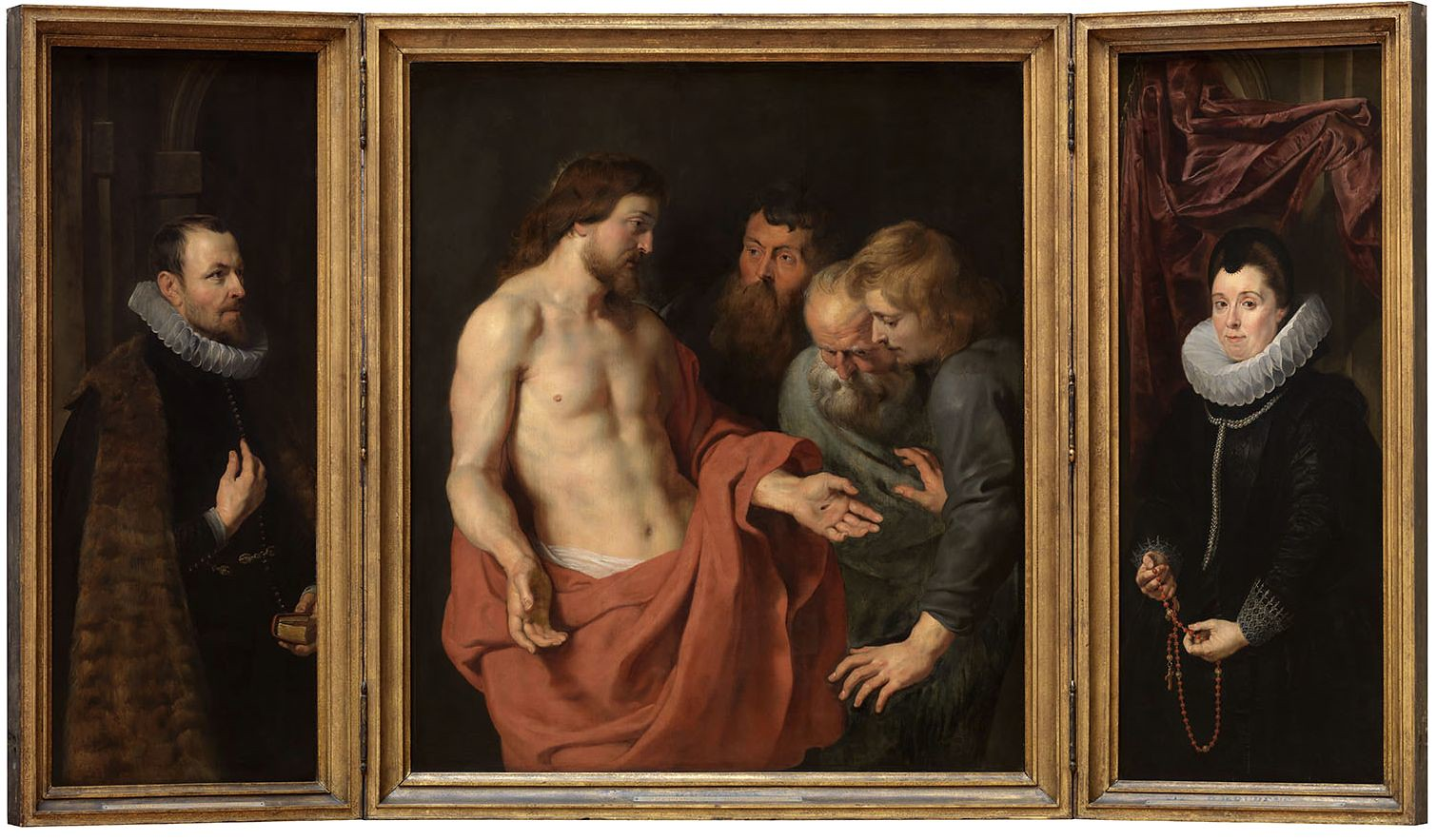
rubens, the epitaph of nicolaas rockox and adriana perez. 1613-15
center: christ appearing to his disciples
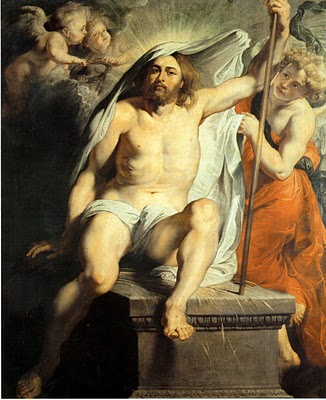
Peter Paul Rubens, The Resurrected Christ, c. 1616
symbolizing resurrection and triumph over death
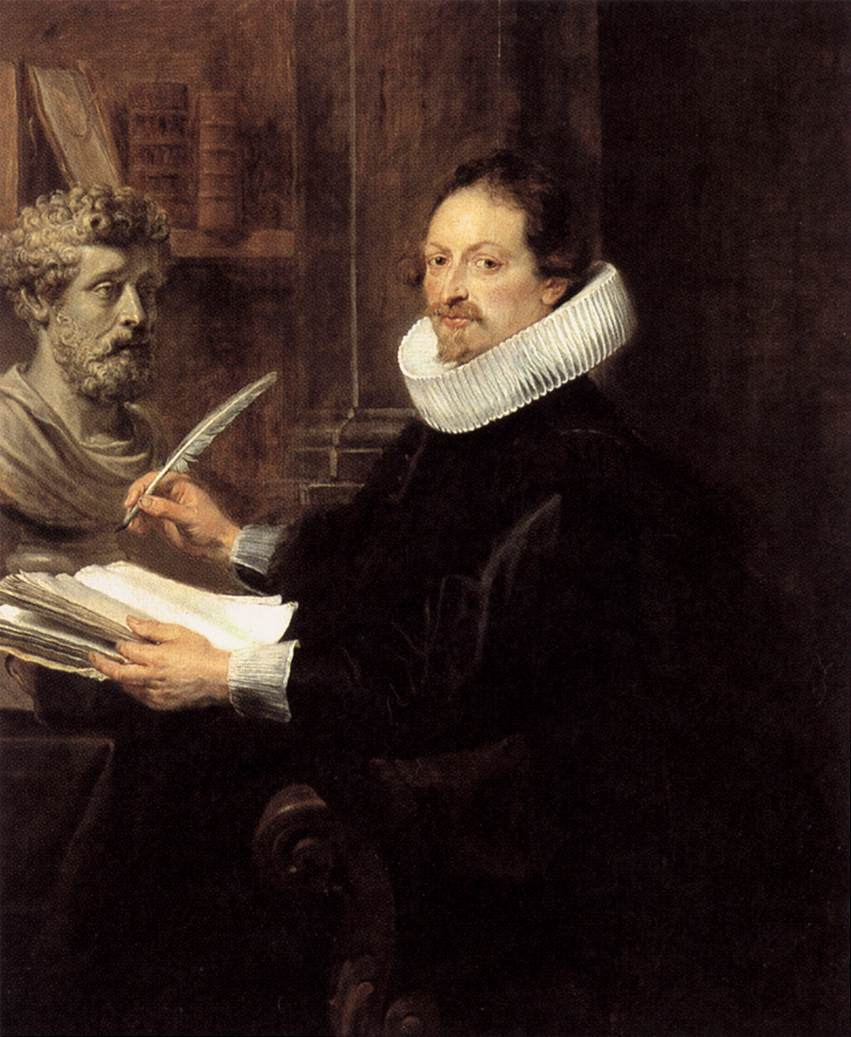
rubens, jan caspar gevarts, 1625
captures his likeness and status
personal friend of rubens

Rubens, Le Coup de Lance (The stroke of the lance) c. 1619
as if we were participating in the crucifixion because of the side ground view
Focus on Christ and contrast between left and right groups
brutal and physical elements
The moment of death of Christ
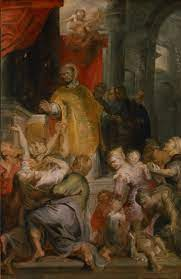
Rubens, The Miracles of St. Ignatius Loyola
1616-17
depicting the miracles associated with St. Ignatius Loyola
Commissioned by the Jesuits
reflect the devotion of the counter-reformation
highly charged and coming right to the viewer
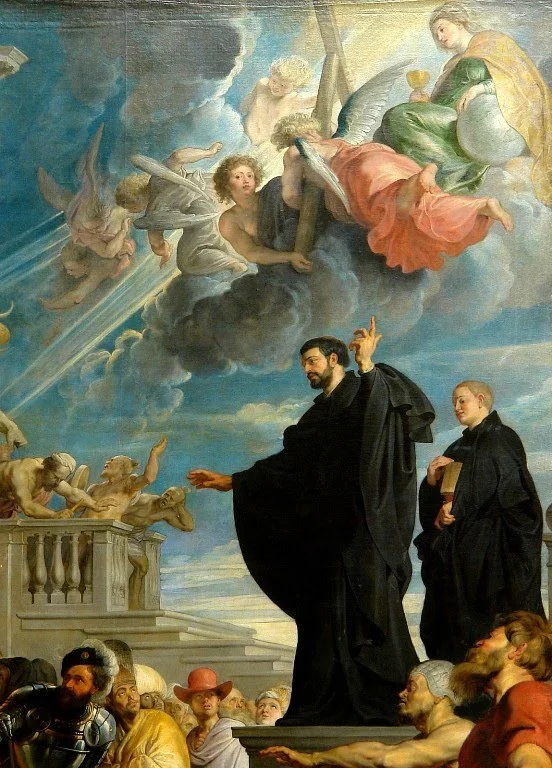
The Miracles of St. Francis Xavier 1616-17
person preaching and teaching is firm
everyone else is chaotic and turbulent
lots of ethnicities
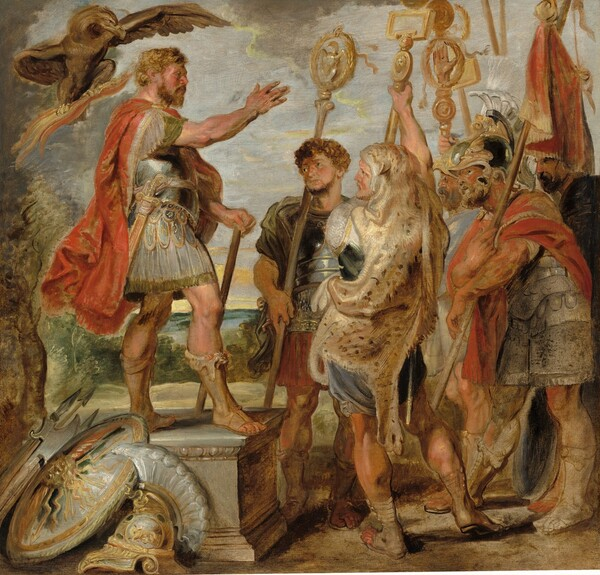
Rubens, decius mus tells his dream to his officers, oil sketch for tapestry, 1617
there was a desire for tapestries
Inspired by antiquity
actual tapestry took forever to make, more valuable than original sketch
wide range of subjects in tapestries
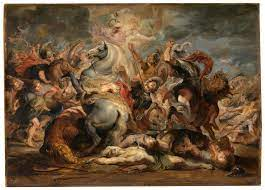
rubens, death of decius mus, 1617
inspired by retouched “the battle of anghiari” of leonardo da vinci
interweaving horses
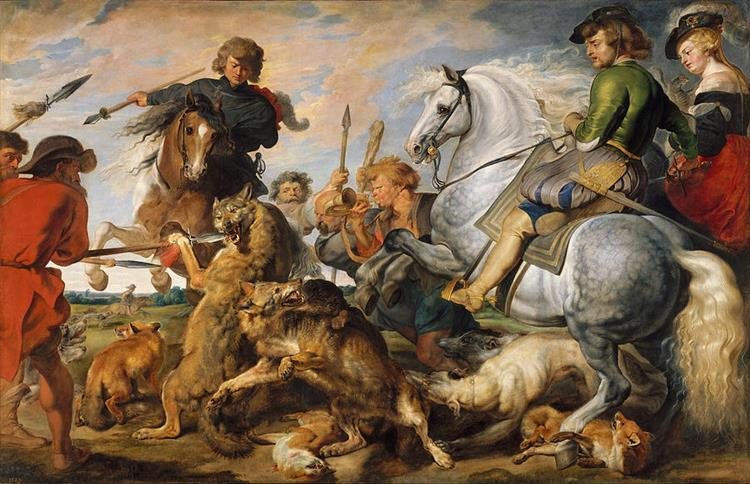
rubens, wolf and fox hunt, c. 1616
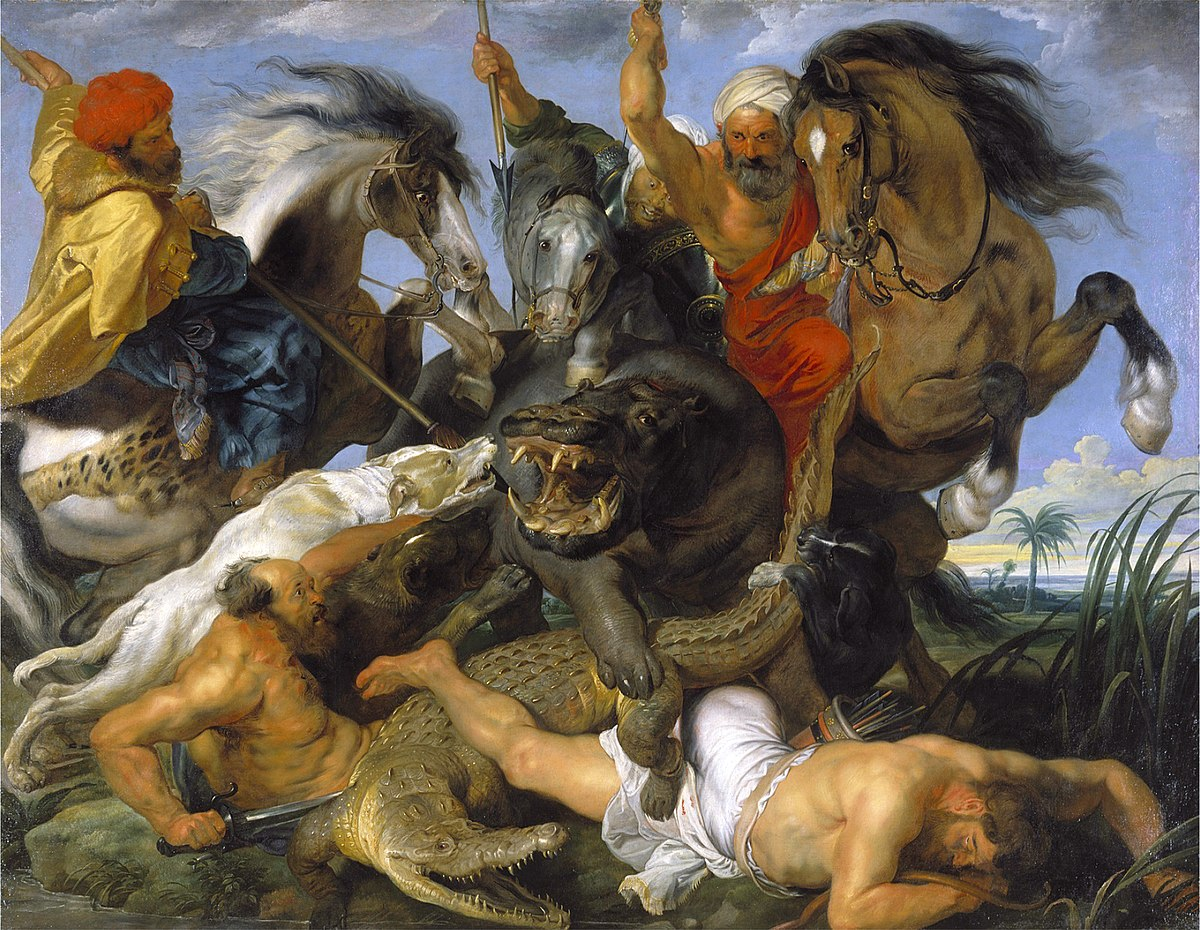
rubens, crocodile and hippopotamus hunt, 1615-17
viewed as an appropriate way for aristocrats to keep their wartime skills by hunting
masde for duke of bavaria

rubens, the abduction of the daughters of leucippus, 1617-18
tangled again
large figures right in the foreground
based off a mythological narrative
emphasis of sensuality and emotional drama
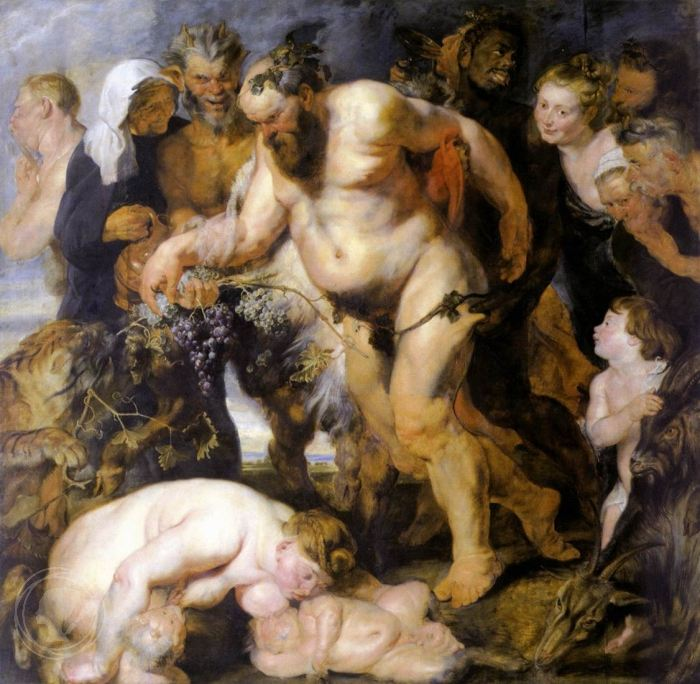
rubens, drunken silenus 1616-17
looks like the whole thing is gonna come tumbling out into our space
depicts silenus, a character from greek mythology
rouching, closeness
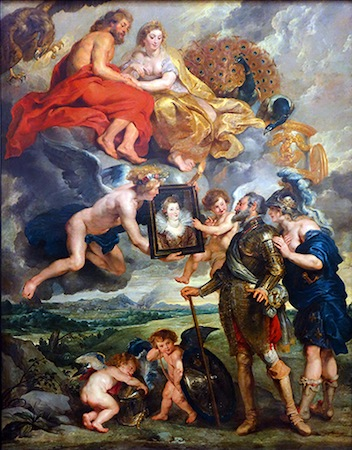
Rubens, Henri IV Receives Portrait of Marie, from the Life of Marie de Medici 1621-25
a painting that combined a real portrait and real history with mythology
tall painting, about 13 feet
henri looks stunned at the portrait
a oersib represents france, telling him she’s the one
there’s 24 pictures like this
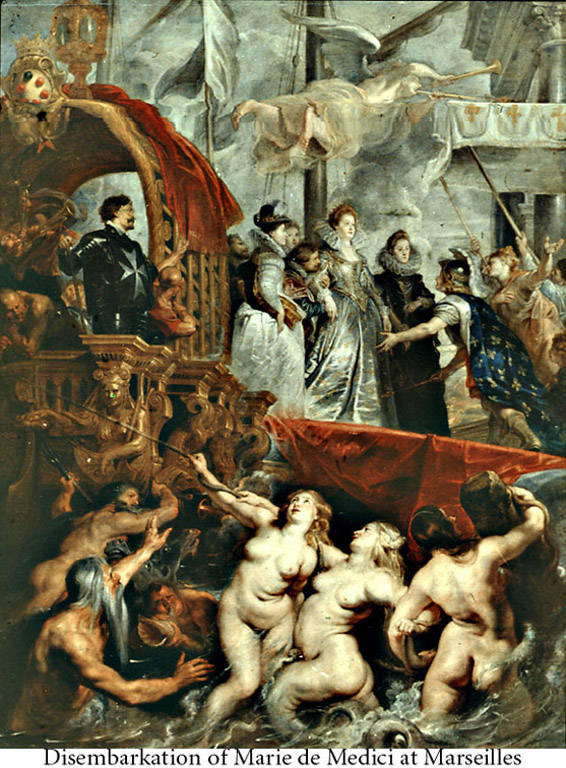
Rubens, the arrival of marie at marseilles, 1621-25
grandiose and overblown again
has nothing to do with the reality of the situation
painting an idealized reality
depicts arrival of marie, queen of france
commissioned series for the luxembourg palace in paris

rubens. the marriage of henri and marie, 1621-25
they became jupiter and juno
lions in the painting, relating to the city of Leon
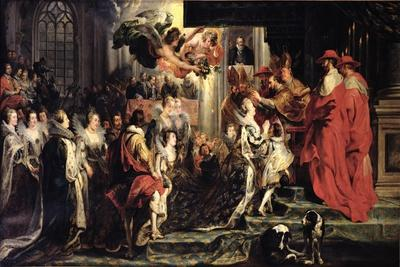
rubens, The coronation of marie 1621-25
insisting upon her coronation
dogs associated with aristocracy
hunting animals, elevated status
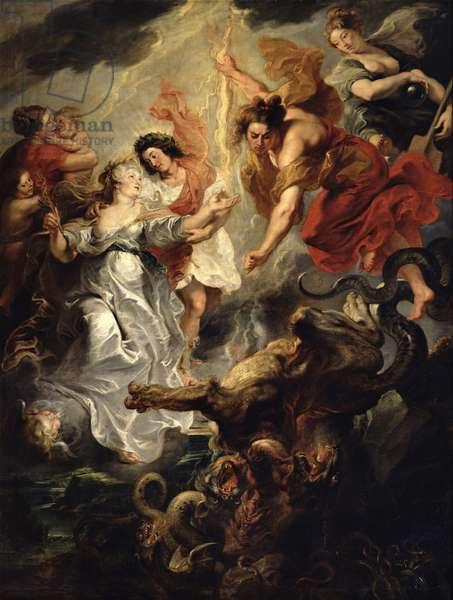
Rubens, the reconciliation of Marie and Louis XIII, 1621-25
Inspiration taken from some religious paintings
reconciliation of Marie with her son, Louis 8, marking a crucial moment of unity in the French monarchy
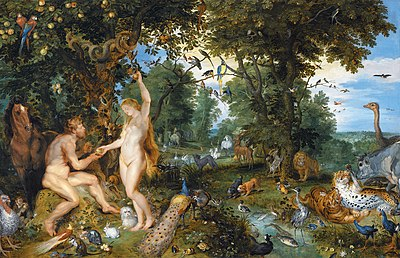
Rubens and Jan Brueghel the Elder, Paradise, c. 1620
example of collaboration with other Antwerp artists
Adam and Eve were painted by Rubens
Everything else was painted by Jan
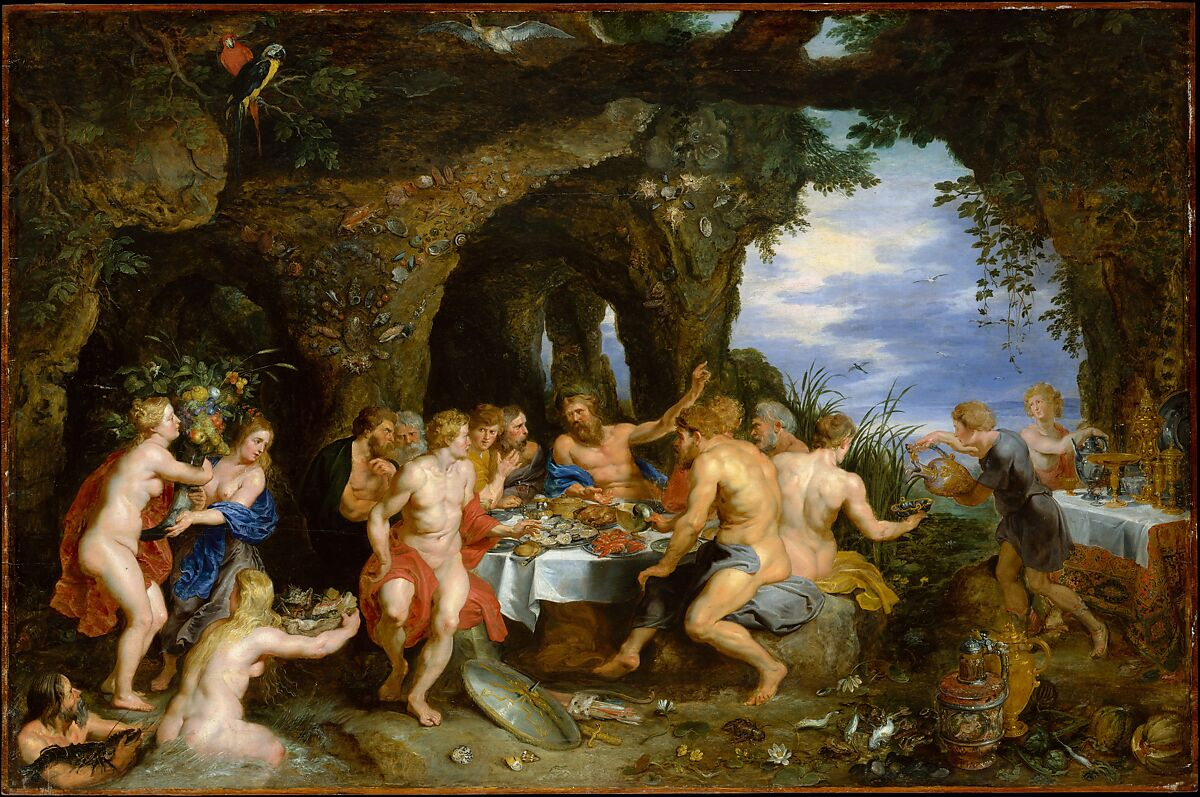
Rubens and Jan, The feast of Achelous, c. 1615
Guy pointing to an island that used to be his wife, a nymph
lots of shells in this photo, Antwerp became a place of exotic stuff so the shells show this
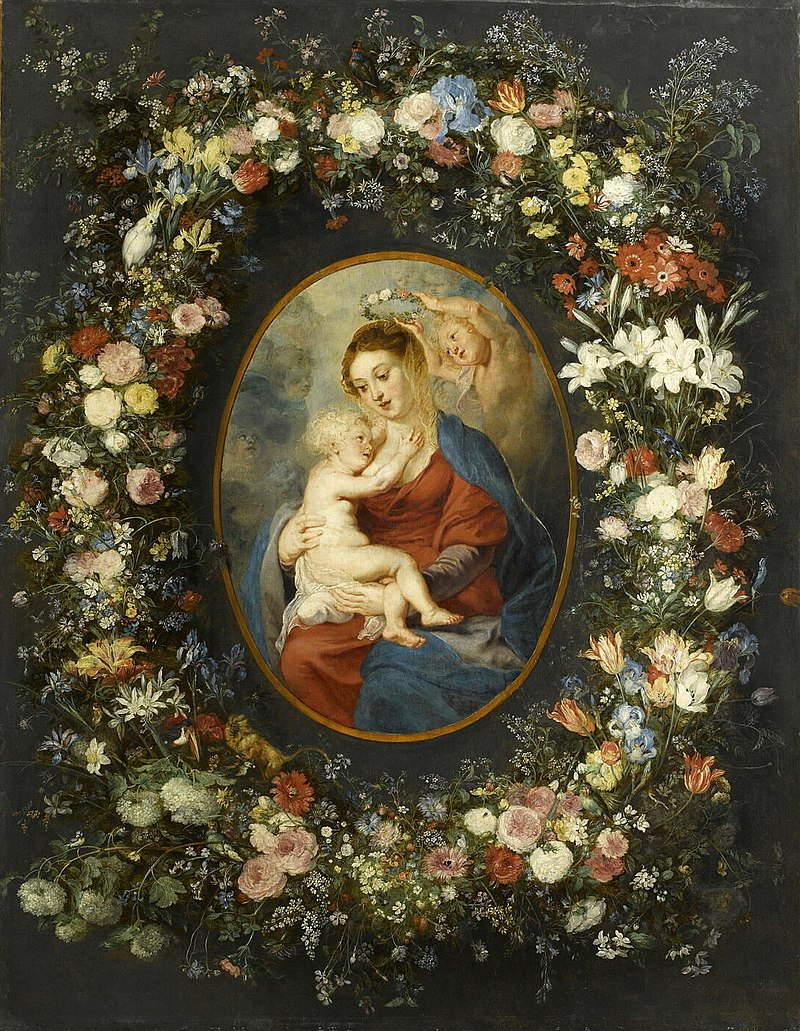
Ruben and Jan, Virgin and Child in Flower Garland, 1618-20
Cupids and person painted by Rubens, rest by jan
virgin mary and infant jesus
inclusion of the flower garden adds a layer of symbolic beauty to the religious subject
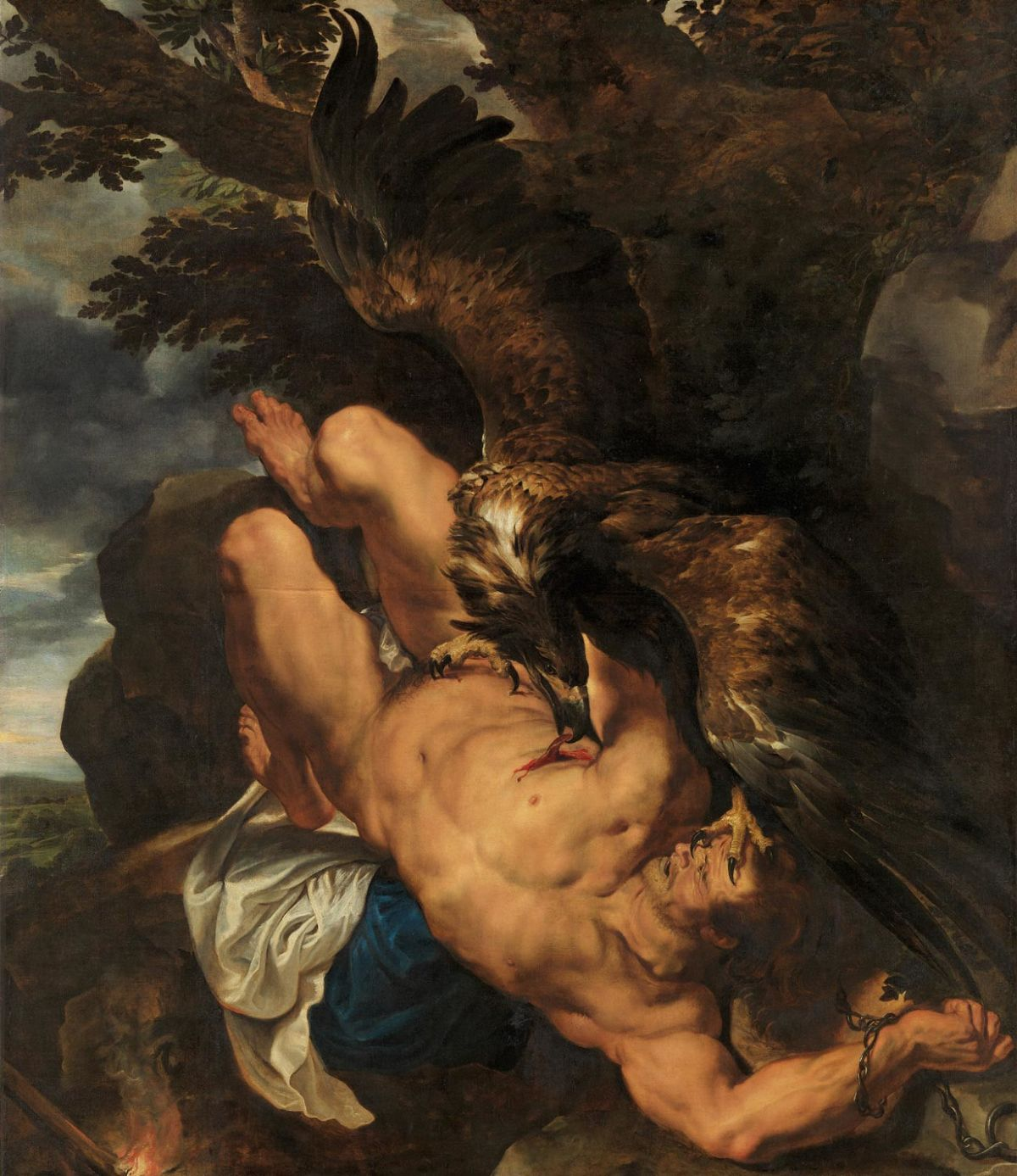
Rubens and Snyders, Prometheus 1611-12
Snyder did the eagle, rubens did Prometheus

Rubens, adam and eve, 1628-29
based off a titian painting
bird added representing paradise
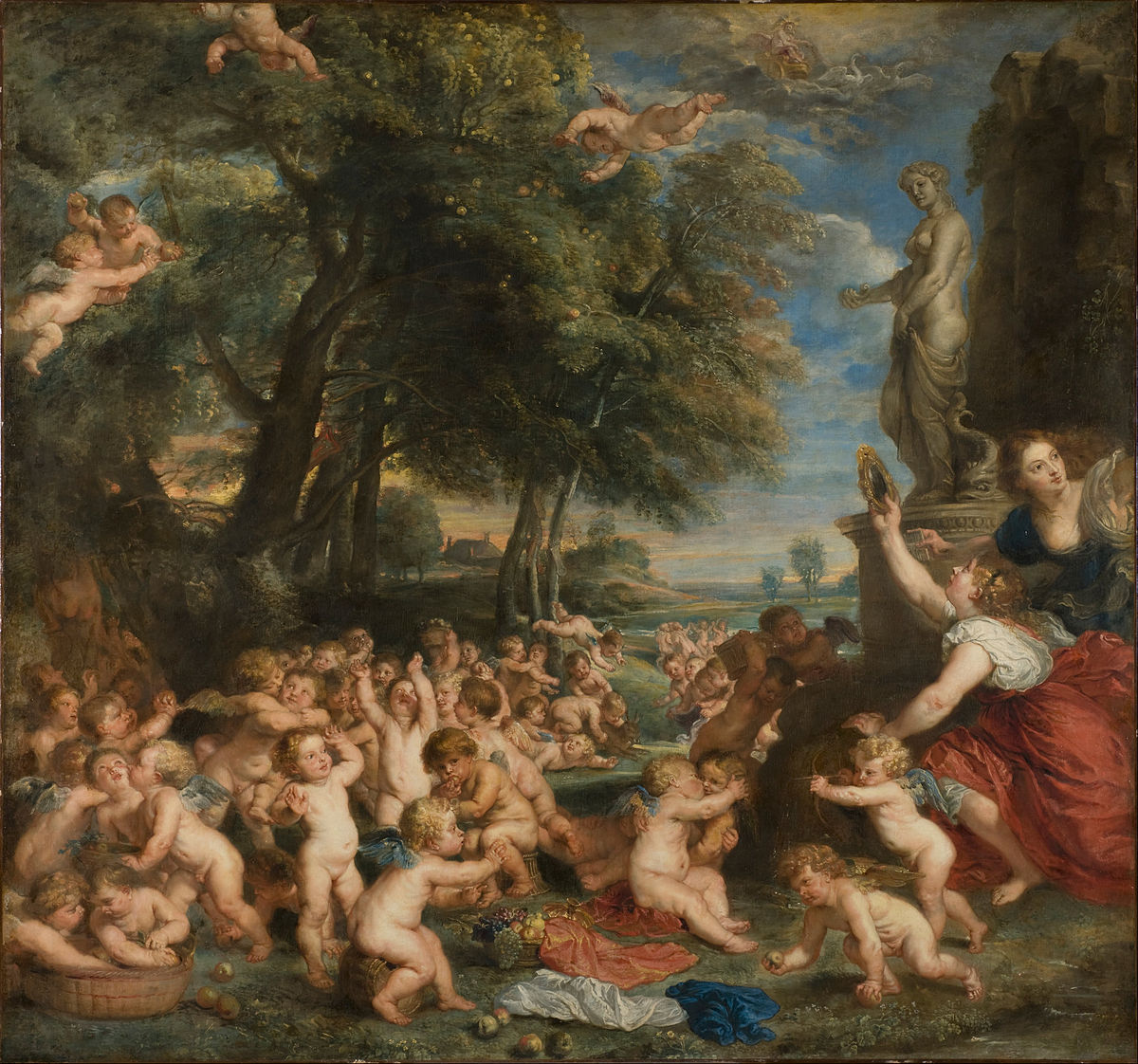
rubens, The worship of Venus, 1628
style is more flowy, paint-like, looser, brushier
copied from one of the spanish royal collections of titian
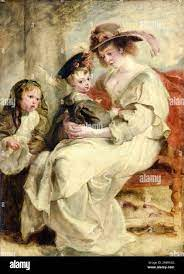
rubens, Hélène Fourment with Two Children, Clara Johanna and Frans, c. 1636
family portrait with rubens’ second wife and their two children
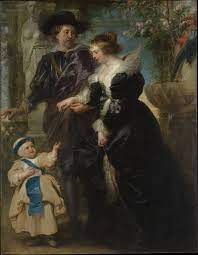
rubens self portrait with helene Fourment and Son Peter Paul, late 1630s
made himself look younger
background is an allusion to his own garden at home but also represents a paradise, more grand than reality
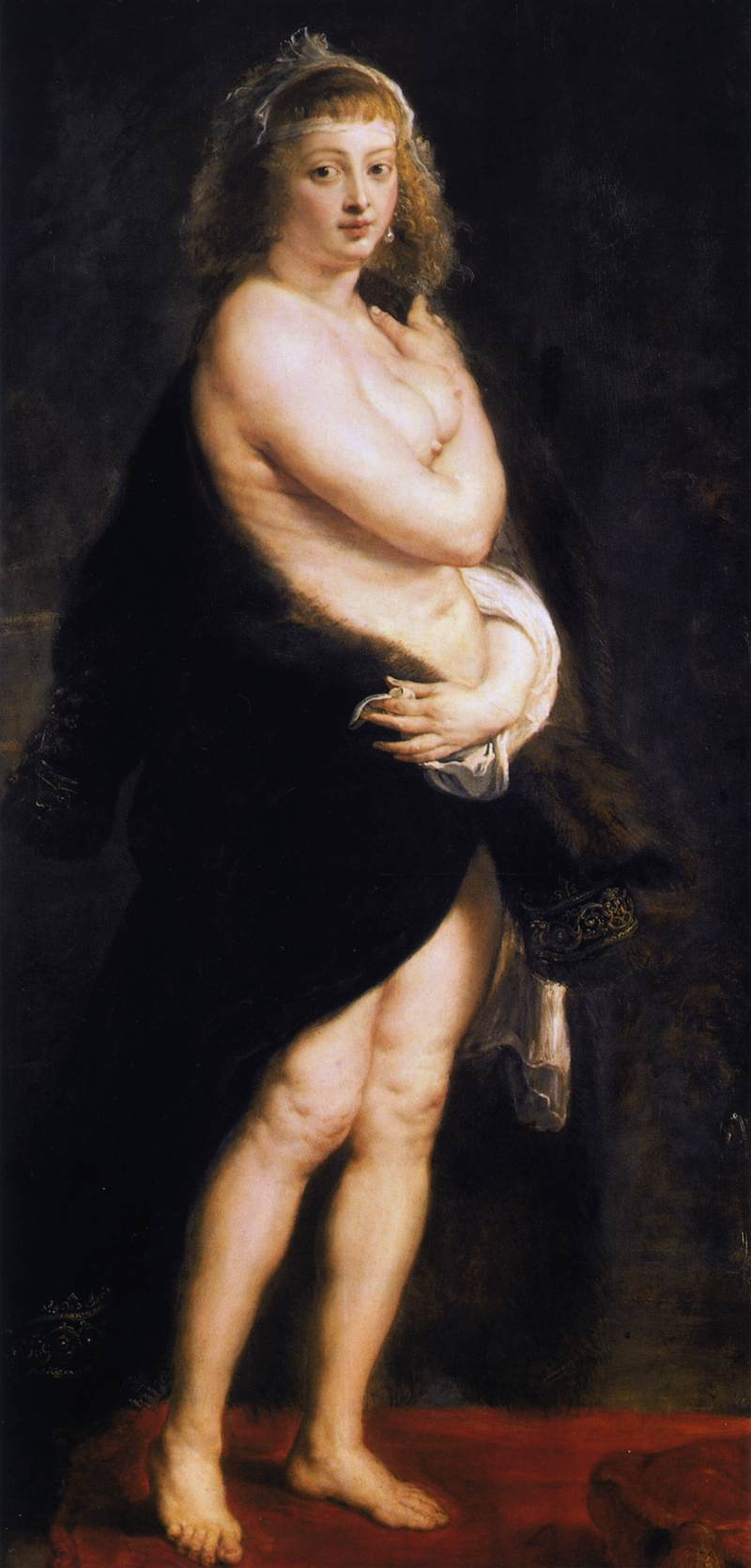
Rubens, Jet Pelsken (The little fur) Helene Fourment as Venus at her bath c. 1636
of his ample, naked wife
possibly interpreting her as Venus, the goddess of love
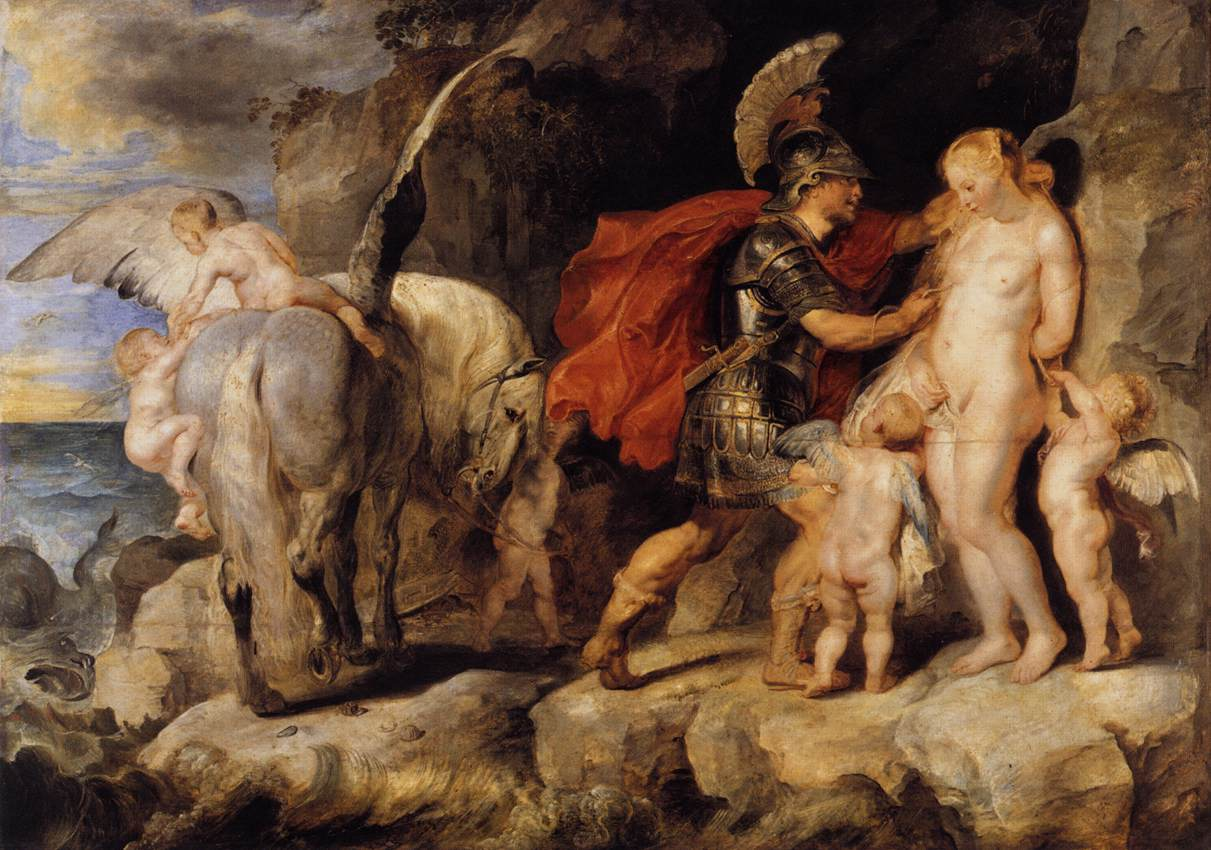
Rubens, perseus and Andromeda, 1619-20
inspired by titian, andromeda and perseus painting
also for a later depiction of andromeda
Depicts a scene from Greek mythology where Perseus, the legendary hero, rescues Andromeda from a sea monster
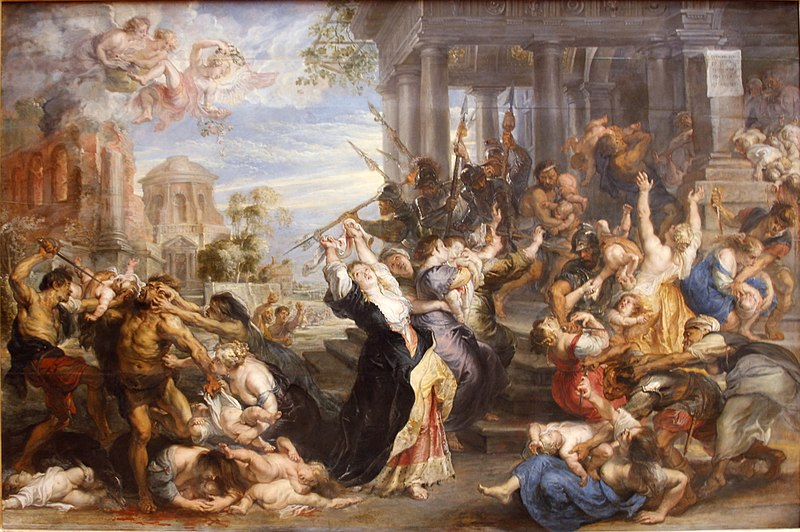
Rubens, the massacre of the innocents, c. 1635
seizing and killing infant babies
mothers fighting to save the children
he also shows that there will be some sort of justice coming in the painting but also doesn’t spare the realism and gore

rubens, the feast of venus, c.. 1636
Lots of cupids, turned into babies at this time
All the babies represents fertility, abundance, fullness
Hoisting garlands
Image about amplitude and fullness of life
He made a female cupid, which is kind of a contradiction
Cupid is the son of Venus
For Rubens, human female is the center of love
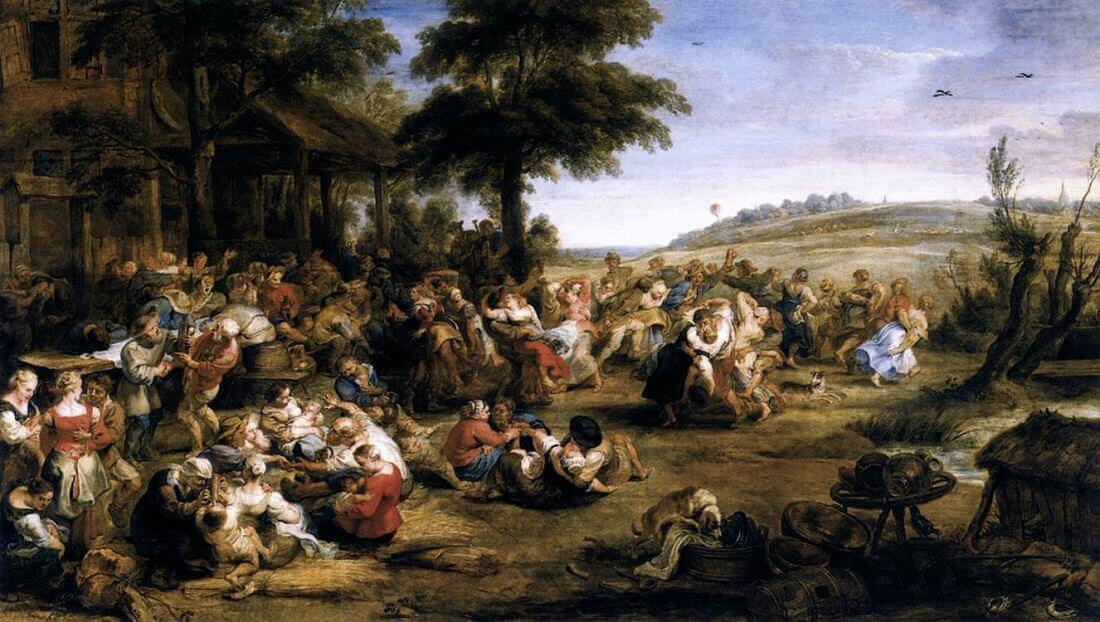
rubens, flemish kermis, c. 1630
unusual paiting for this time in his career
karamis is like a darty for more chaotic
people dancing wildly, giving beer to kids, drunk
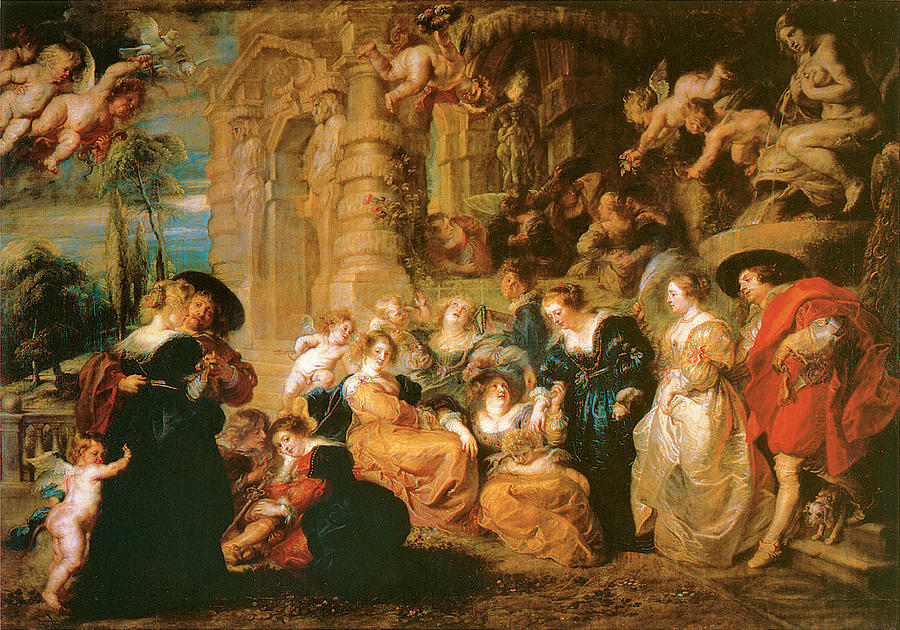
Rubens, The Garden of Love or Conversatie á la Mode (Fashionable Conversation), c. 1630-32
Depicts couples coming into the realm of Venus
Signified by a large sculpture of Venus with water coming out of her
Image about the process of falling in love
A combination of real social behaviors conjoined with mythological and allegorical figures
Part fantasy part real
Rubens is not an artist of reality, he constructs his own reality
Venus’ breasts represent an overabundance of fertility and fullness
Two couples entering the garden of love on both sides
Another couple where things aren’t going too well which is why the cupid there isn’t too happy
The background is a garden grotto, pavilion thing
Random water coming out of stones and stuff happening to the couple being courted, common thing in old european gardens
The three graces are in there too
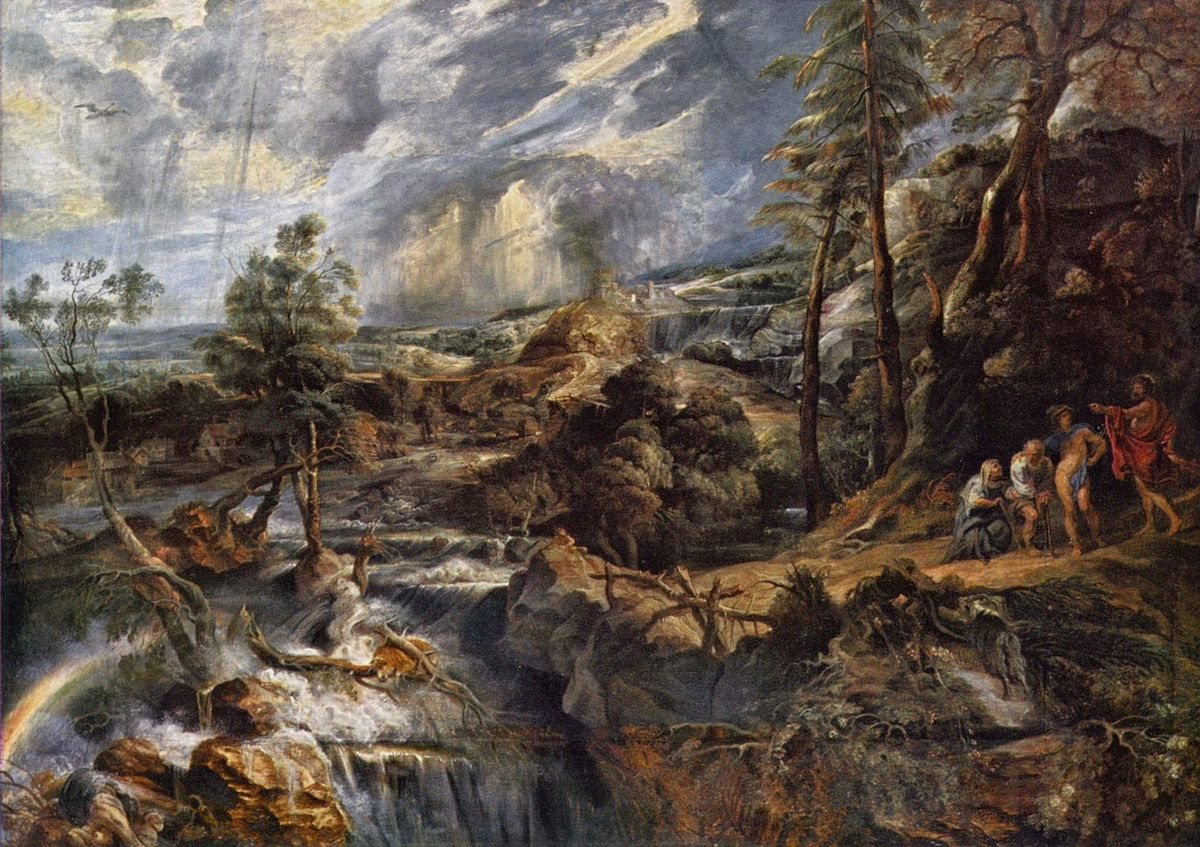
rubens, landscape with philemon and Baucis, c. 1624
Rubens treated landscape as a dramatic scene
Phil and Bauc were wandering a village asking for help and only an elderly couple helped them
Jupiter destroyed the village because of lack of hospitality, warned the elderly couple though
In the painting, there has been a storm and it is moving away in the distance, still raining over there
Full of movement, energy, surging forces
Rainbow, symbol of regeneration
In the 1630s, rubens becomes more interested in landscapes
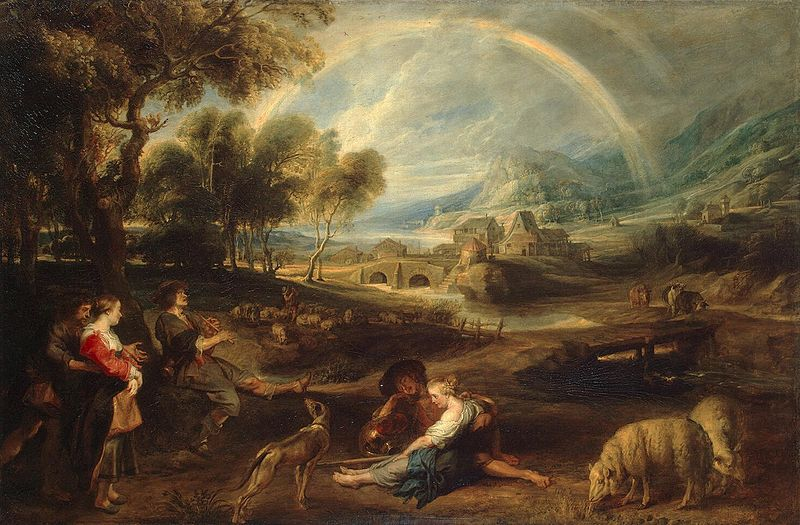
The Rainbow Landscape, 1637
happiness, harmony
period of renewal in his life
partly due to inspiration from the Venetians, good landscape artists
rubens always had some light breaking in like there is good
rubens’ view of the world
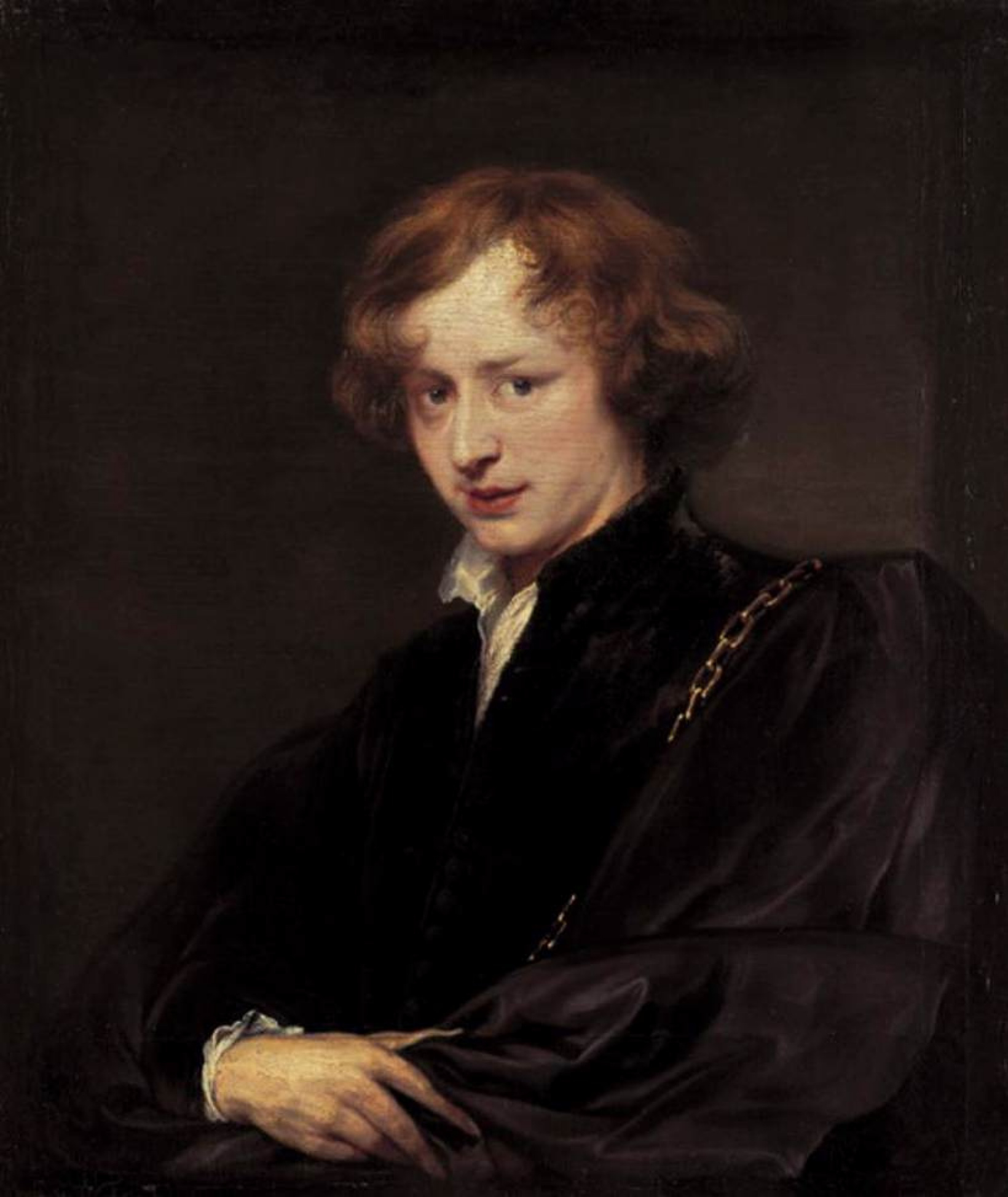
not the same one but similar
VD, Self Portrait, 1618-20
Depicted as melancholy, at this time physiologically = genius
Head down, eyes up, brows low
Just the tips of his fingers touching the edge, meant to suggest aristocracy, hyper sensitivity
Self conscious but exactly the opposite of rubens, character, personality, not shy about claiming he was a genius
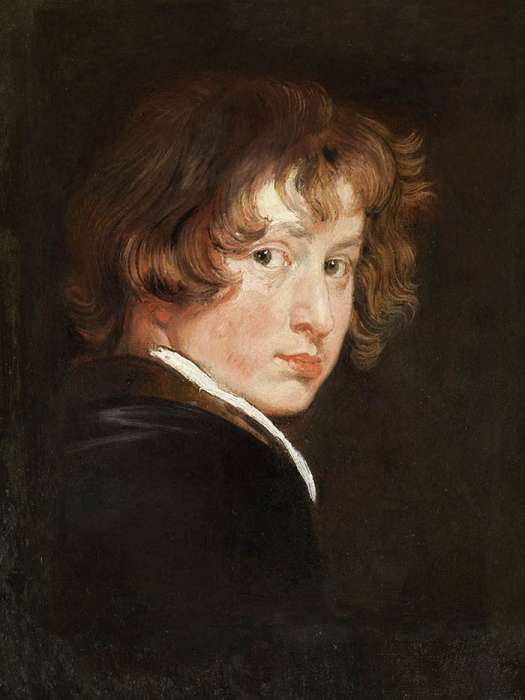
VD, self-portrait, 1613, age 14
Looking over shoulder
Suggesting he’s different
Unusual way for a young artist to depict himself
Assertion of striking individuality

VD, crowing with thorns, 1618-20
Shows how reluctant vd is for making people touch
Gesture but not touching christ
Tormented christ but not touching him

VD, betrayal of Christ, 1618-20
Setting up a rubens like contrast
Rushing figures and stillness of christ
Look like rubens pictures but don’t act like rubens pictures
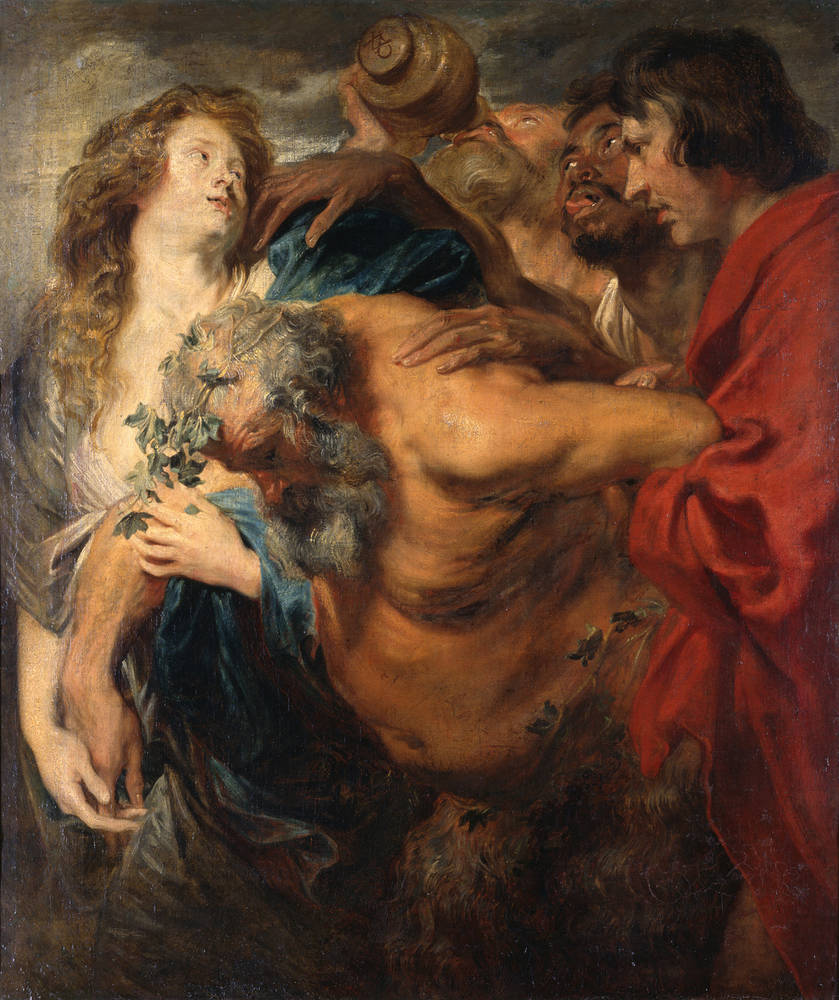
VD Drunken Silenus, 1618-19
Rubens’ version is very hands-on
Hands barely touch in VD
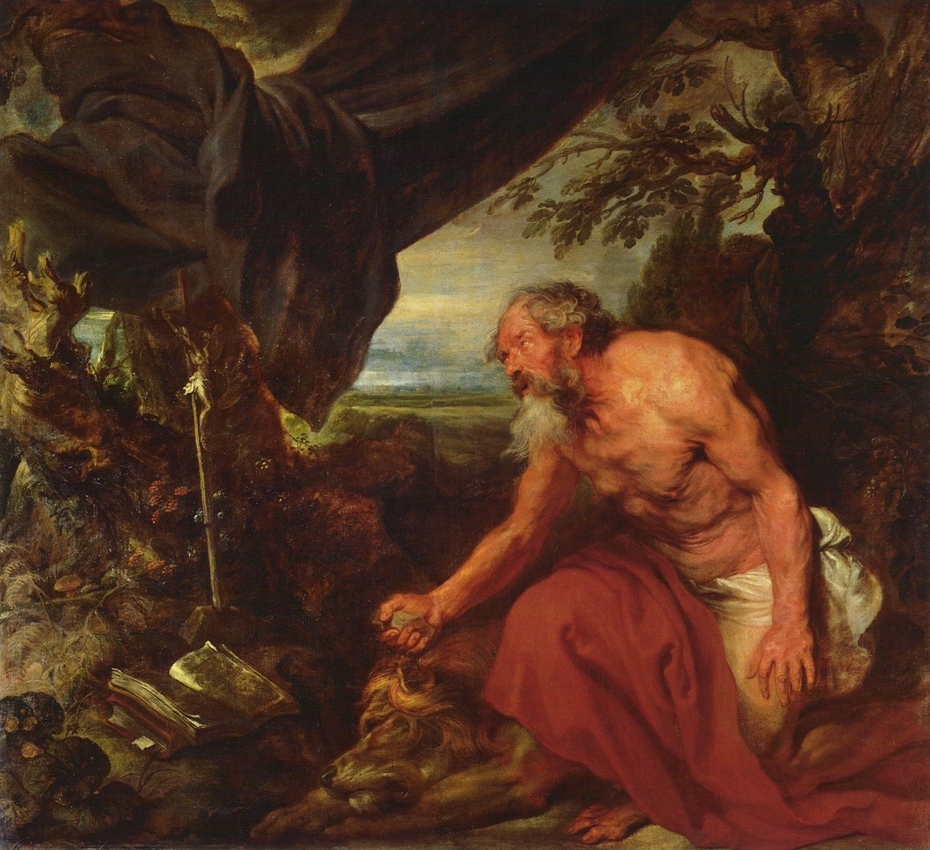
VD, Penitent St. Jerome, 1625
like a titian painting
what are VD portraits like
Elegant, dramatic, controlled
Elongated bodies like marchesa, 1623

VD, Frans Snyders, 1620 | VD, Margareta de Vos, Wife of Frans Snyders, 1620
Lots of standard conventions about marriage
Man is at the viewer’s left, the superior side, husband is head of the family
Wife is on the inferior side, subordinate to the man in all sorts of custom and law
The male figure is typically more active, sometimes standing
The female figure more quiet, still, passive
Light comes from the left, shines across a mans face, makes it more attractive for a man, falls full on woman’s face, more attractive for women
Architectural framework again depicts social status
View out into the countryside, way of linking both the portraits together
Big curtains, fullness, amplitude
Frans is wearing a much more informal collar and is leaning against the back of the chair, more relaxed portrait in general, less rectilinear
Hanging van dyck type hand echos curtains hanging
Forms more graceful, more fluent look more active
The woman though is much more vertical and rigid like the columns
Snyders doesn’t choose to have himself portrayed as a painter but a gentlemen, not working with his hands
The pose type (relaxation) is likely stemmed from paintings like titian’s man with a glove (1520)
Removing a glove has to do with receiving someone
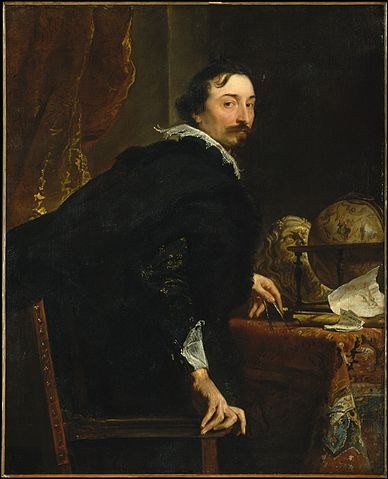
VD, Lucas van Uffelen, 1625
Pose taken from Titian, portrait of a Man, c. 1508-10
Gaze over the shoulder, sense of spontaneity, engagement but also pushing away
Titian, Jacopo Strada, 1567-68 is another example, activated portrait
In the Lucas portrait, he is rising from his chair, he is interrupted in his studies
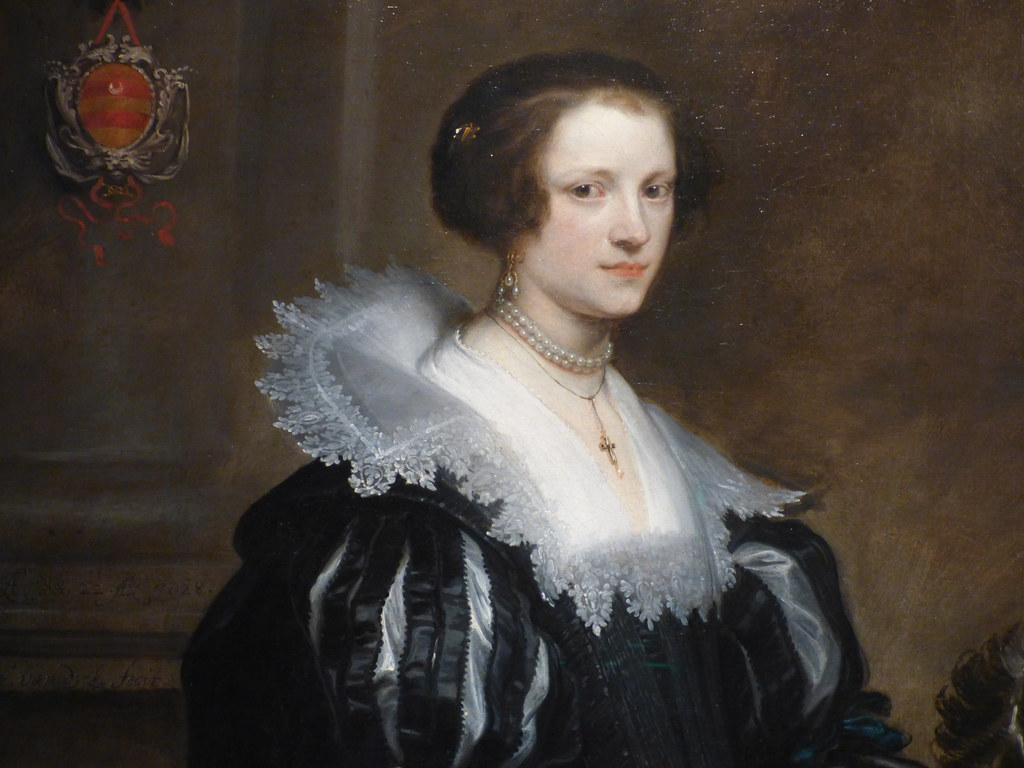
VD Anna Wake Stevens, 1628, VD Peeter Stevens, 1627
VD was big on English aristocracy
He was good at capturing the likeness of an individual
This is another pair but the man is on the left for some reason
He is clearly gesturing at her
Light is coming from the right this time too
Wife is still still and man more active
Three quarter length portrait, much more common in Antwerp
These portraits are about capturing their social identities

VD, Maria Louise de Tassis, 1630
Both anna and maria are dressed in the height of fashion
Both are holding fans
The way they are holding their fans is the female equivalent of the man taking off his glove
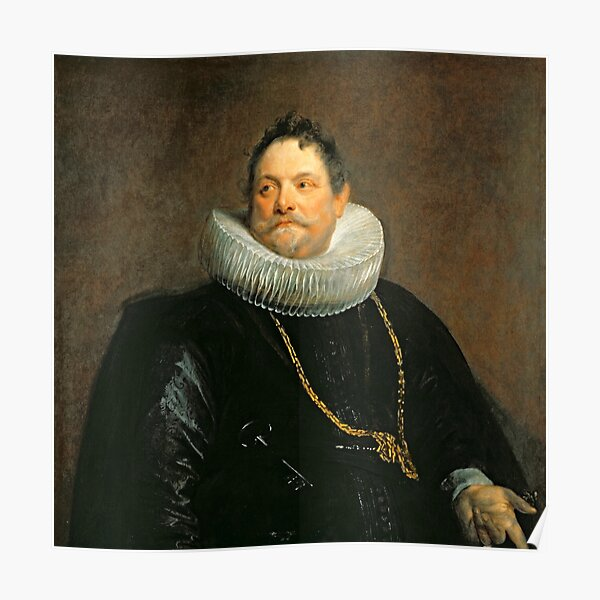
VD, Jan van Montfoort, 1628
Pose inspired by Titian, Doge Andrea Gritti, 1540
Mintmaster
Is wearing a gold chain, very valuable but also a token of status
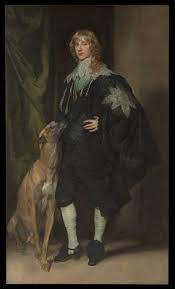
VD James Stuart, Duke of Richmond and Lennox, 1634-35
We see that vd provides and image for the nobility that shows superiority
Large quantities of cloth indicated wealth
Large masonry objects indicated wealth
Dogs indicated hunting, noble pursuit
Daniel’s is stiff, VD’s is at ease, indicates he is at ease with being noble, doesn’t have to try
The type derives from Titian, Emperor Charles V, 1533
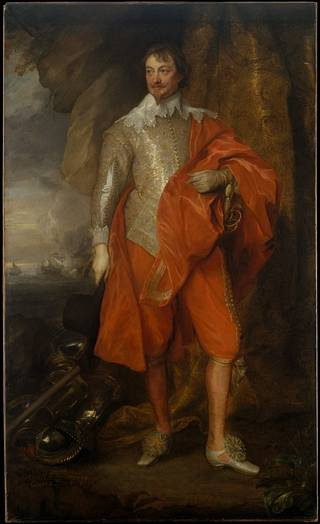
VD Robert Rich, Earl of Warwick
Juxtaposed with rocks, signified fortitude, endurance
Cloth too, wealth and luxury
Naval battle, he fought in
Armor on ground, he was a warrior
The leg pose we see
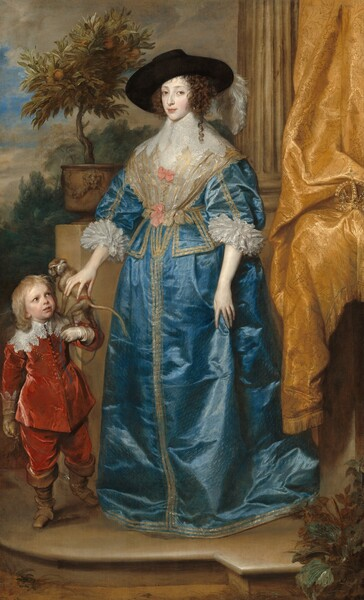
VD, Queen Henrietta Maria and Her Dwarf, Jeffrey Hudson, and Pet Monkey Pug, 1633
Kid was 14
Monkey indicates wealth
No millstone ruff, outfit suggests she is going on the hunt
Set against a column and billowing yellow/gold cloth with crown there nonchalantly
Orange associated with family but also generosity
Made her seem taller but she was shorter than 5 feet
Make her more queenlike
Uses a dwarf to help with this
Same formula as Marchesa Elena Grimaldi with the subordinate, shorter attendant
Depiction of figures that are slightly less formal becomes an ideal of Caroline England
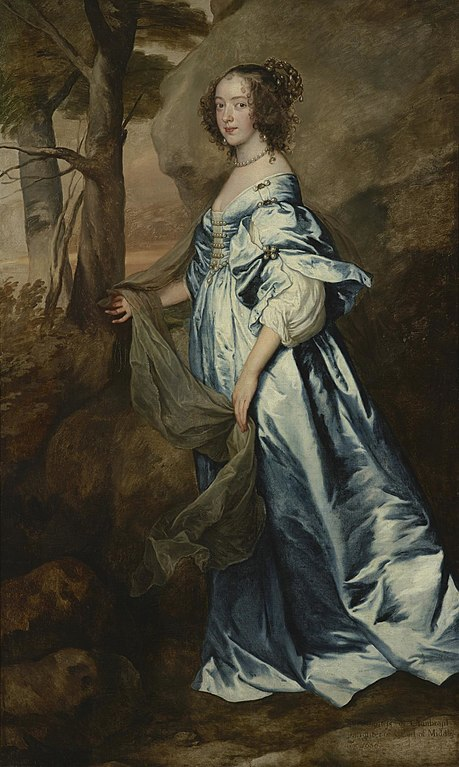
VD, Countess of Clanbrassil, c. 1636
Shown in a less formal dress, more flowing, lacking customary undergarment
He did clothing that wasn’t quite of the present day, did this with many female sitters
Belief that they may quickly look old fashioned if they wore very current clothing
Less formal shows more freedom
She’s in the country, enhances hint of pastoral in the clothing
The stone juxtaposition too, felt to make the women more beautiful by contrast against the roughness and massiveness of the stone
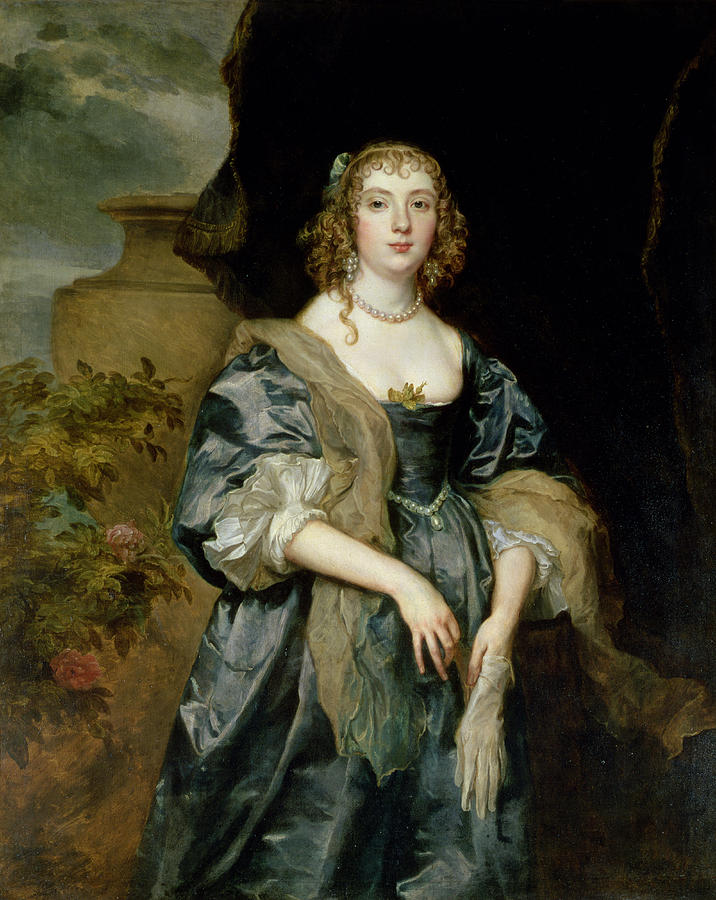
VD Lady Anne Carr, Countess of Bedford, c. 1638
Vase, woman’s beauty and figure like vase
Clothing isn’t super current, freedom, ease, nonchalance, effortlessly beautiful

Gerrit van Honthorst, Charles 1 and Henrietta Maria… 1628
These masques, short allegorical dramatic entertainment performed by masked actors
In the court of Charles 1, there was a performance
The picture depicts what is referred to as historiated portraits, idea of people in portraits as characters from history, the bible, allegorical characters
These were big in the 17th and 18th century
Charles and henrietta are depicted as apollo and diana receiving mercury
Very closely related to what we find in France at the same time
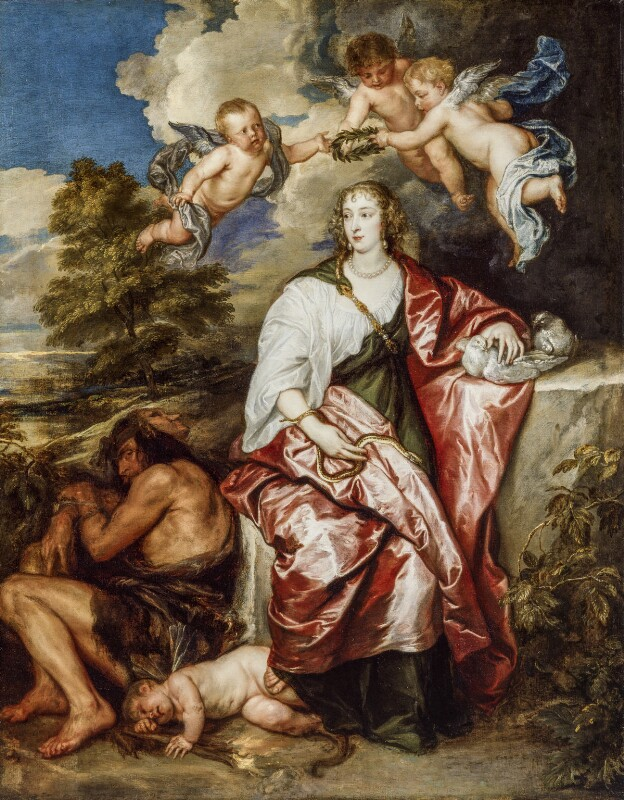
VD Lady Venetia Digby, as Prudence, 1633
Not current clothing
Resting foot on cupid asleep
Two faced figure there
Doves in hand
Cupids overhead
Snake in hand
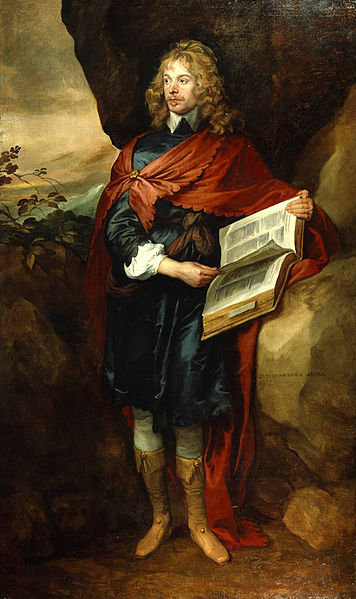
VD sir john suckling, 1632
Seems normal but costume is unusual
Scalloped edging suggests something rustic
Costume and book suggests he's a sort of poet, literary man
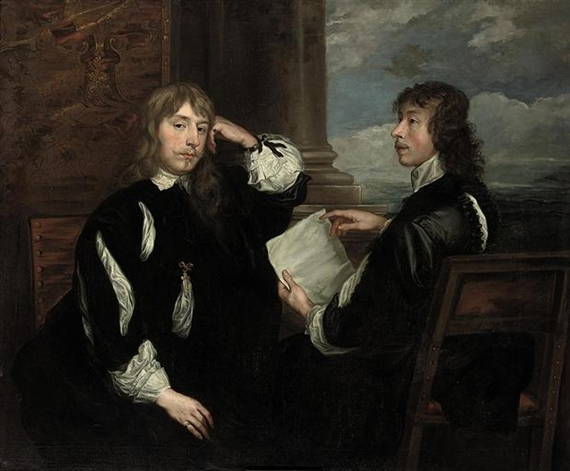
VD, thomas killigrew and william, lord crofts, 1638
Blasted column but still standing, fortitude
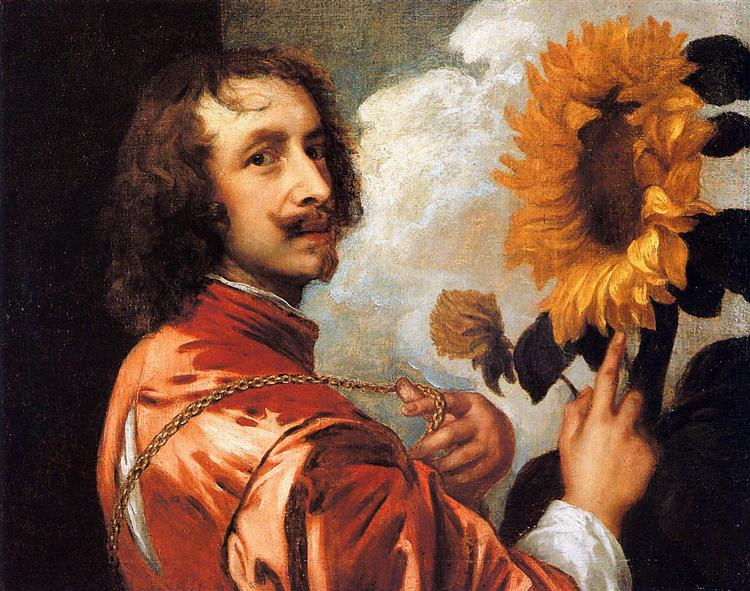
VD, portrait with a sunflower, 1632-33
Fingers a gold chain
Points to a sunflower with the other
The sunflower follows the sun through the sky
Equating himself as a loyal king’s man
He is like the sunflower who follows the sun, king charles
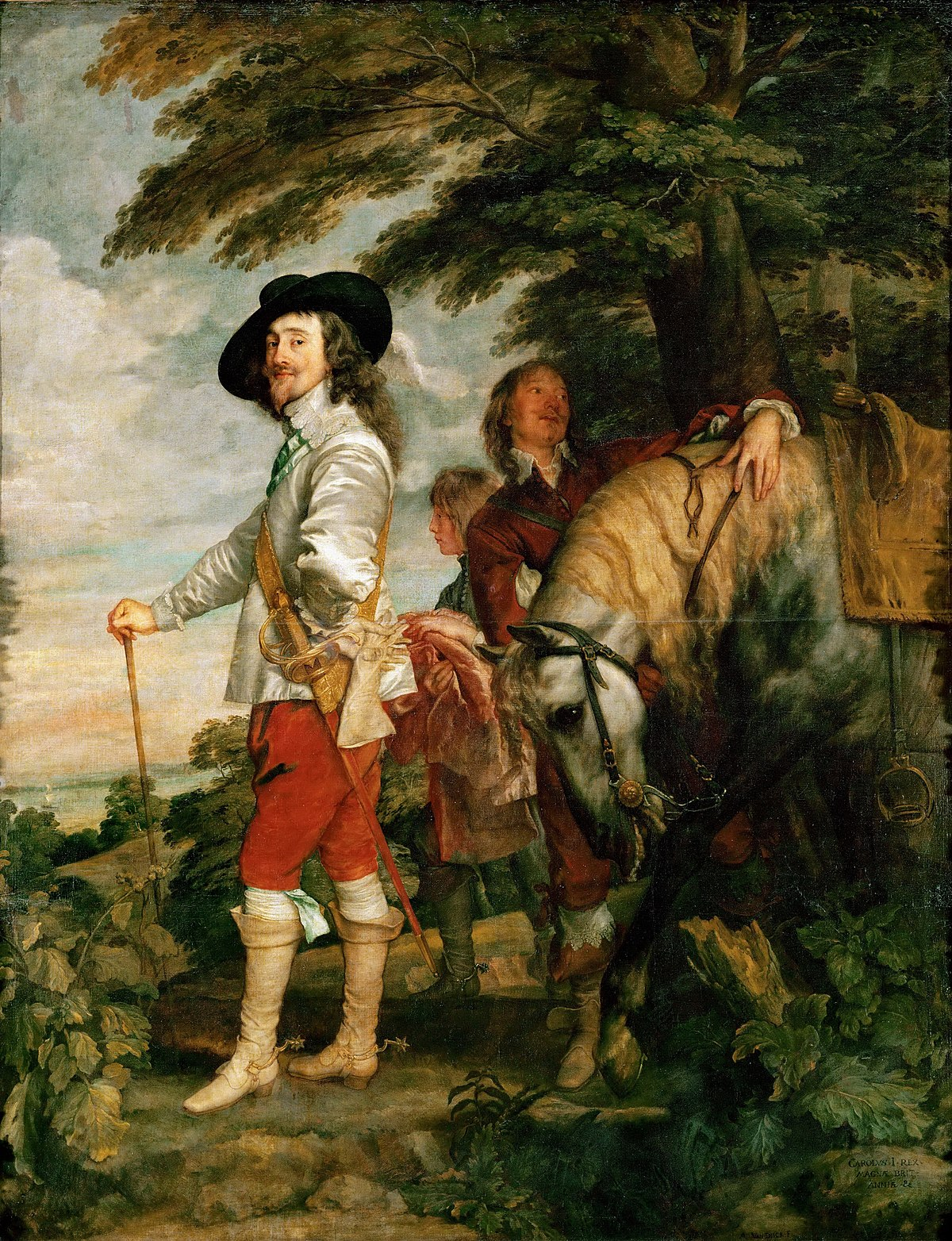
VD, Charles I at the Hunt, 1636-38
hunting, popular for European aristocracy
shows dignity and grandeur but also human qualities
Less out there like other kings’ portraits
Seems to have dismounted from the horse
Surveying the countryside
Has become aware of us, turns and opens his shoulder to us
Completely relaxed
Baroque elbow, coming right at us
Not trying to impress us
Seems divided right down the middle
He is the dominant figure on the left side
On the other side, posed in such a way to be shorter than charles
Charles was short, just over five feet
Horse bowing his head, serves to enhance the stature of charles
Leaves form a canopy over his head
Implication is that he is a king without trying to be king
Only thing that indicates status is the cane like with henry IV
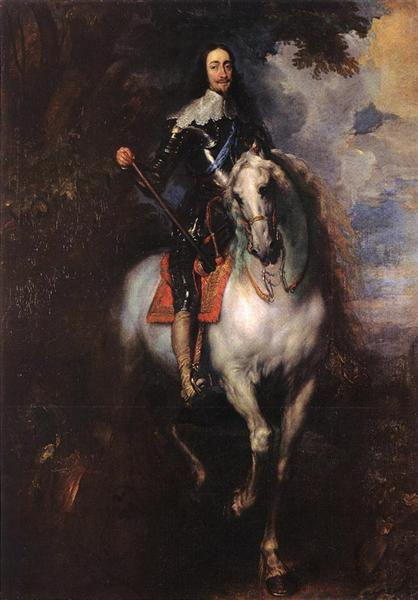
VD, equestrian portrait of Charles I, 1635
royal portrait
symbolizes power and authority as monarch
Much more elongated than reality
Elongated without looking distorted
Horse and rider taken straight from rubens
Suggests easy command over a powerful mammal
These paintings serve to make Charles a natural king
VD, the vision of St. Herman Joseph 1630
Monk of the premonstratensian or Norbertine Order, aka white canons
Figures very large. Close to viewer
Figures blur from the edges into the background or grayish atmosphere
Came straight from the venetians like titian
A kind of removal from a wider, deeper, 3d
He suggests something more mystical, not 3d
Lots of diagonals, circulation of the image that ties the parts together
Mary barely or doesn’t touch her palm, suggestion of spiritual contact that is evanescent
VD, Virgin and Child with St. Rosalie and Sts. Peter and Paul, 1629
Intensity of emotion
St rosalie is a saint in palermo, 12th century saint
She is gigantic
Forms have a hazed quality
Compositional type with mary and christ child and monumental architecture comes straight from Venice
The lillies on the ground, a symbol of purity
The skull, seen from underneath, idk
VD, Virgin and Child with St. Catherine of Alexandria, c. 1630
Charming, sweet baby
People looking intently
VD, Rest on the flight into Egypt c. 1630
Formed tight group
Melancholy mood has to do with the sleeping child who is dead
VD, Lamentation over the dead Christ, 1634
Mary and christ form a very tight group in the foreground
Unnatural way for a body to lie, tilted upward to display the body to us
Tipped over cross enhances triangular structure of composition
Dark cloud, associated with the death of Christ
VD, The Raising of the Cross, 1630-31
Christ is much more tightly nailed than Christ, much less straining, like he is trying to avoid heavy grasping and tugging
Striking silhouetted against the sky, isolated against the sky
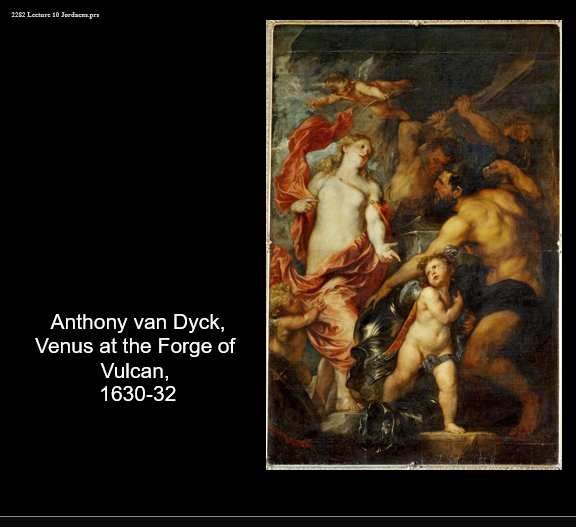
VD, Venus at the Forge of Vulcan, 1630-32
Venus on the left, arriving at the forge
Image of seduction, head turned back, body thrusted forward, vulcan staring at her and cupid, her son looking back at her
Seductive but no touching, fall in love just by seeing her
Like charles on the hunt, venus is isolated on one side, more emphasis on her
Billowing cloaks, not seem to be moved by any wind, visual expressions of emotional intensity
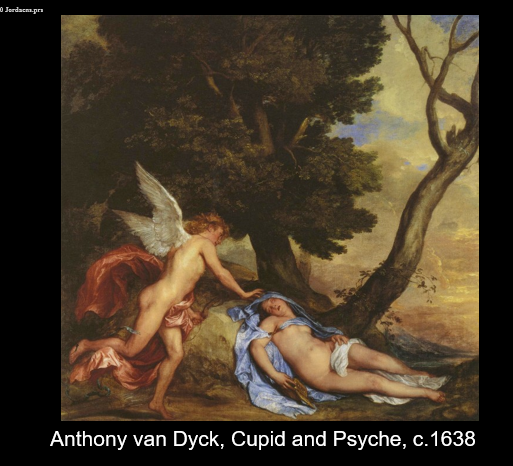
VD, Cupid and Psyche, c. 1638
Image has to do with, again, completely falling in love just by sight
Cupid arrives and immediately falls in love, looks like he is landing lightly
Derived straight from Titian
Intense expression on cupid’s face

VD, Rinaldo and Armida, 1629
Something he painted for Charles before working for him
Large painting
Subject comes from an italian romance epic, Gerusalemme liberata
A romance epic set in the time of the first crusade
A category of romance literature that was popular at the time
Subject involves the hero, Rinaldo, on his way to besiege Jersuluam and comes across a witch who hatches a plot to keep him from joining the forces of Jerusulum, nymph singing a song that makes him go to sleep but she falls in love with him
Billowing drapery expressing intense feeling
Circulating motion
Glowing highlights
Almost see but don’t quite see the faces, leaves room for imagination
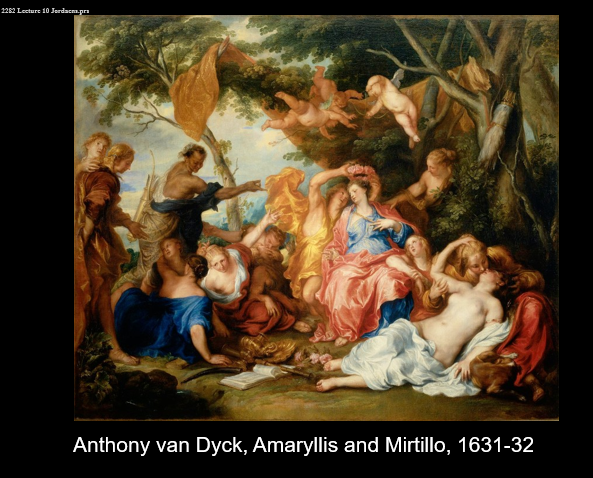
VD, Amaryllis and Mirtillo, 1631-32
Based on pastoral (idealized vision of human beings outside ordinary societal structures) drama, episode from Giovanni Battista Guarini’s Pastor Fido
Involves a kissing contest among female shepherds
He disguises himself as a woman and wins
Women kissing each other, pastoral ideal, less restrained, a society removed from most norms
Clothing that flows off the shoulders, partly showing breasts

•Interpretation of Rubens-like style
•Everyone is a little fatter, skin tones are more red
•Shadows are more of a blueish purple quality
•Figures full of amplitude
•Jacob likes to bring the figures right up to the foreground, bursting into the picture space
•He has a striking taste for having fragmentary figures on the side, like the person on the left
•The boy blowing on the fire to make the flames brighter, picked up from Rubens, allusion to classical antiquity
•Multiple sources of illumination by Rubens as well
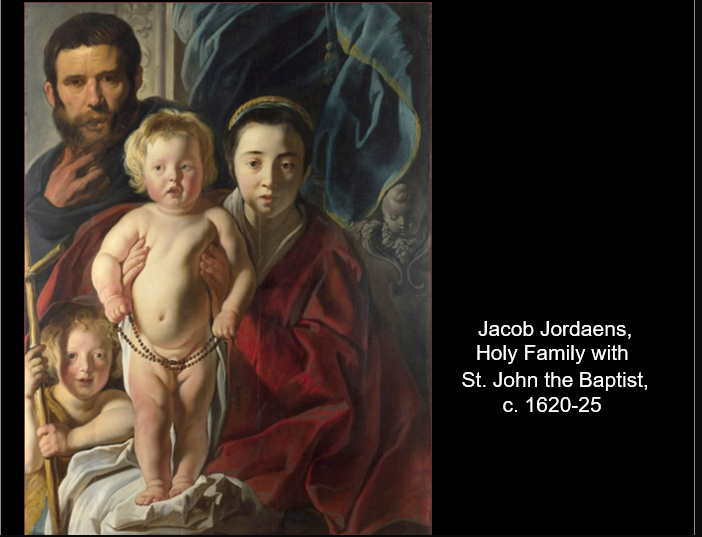
The three figures looking directly at us, looking to engage the viewer, much like Rubens again

Produced many allegorical and mythological as well as religious art
Goddess of gardening
The huge cornucopia is being held by a man, crammed full of vegetables and fruits, overflowing abundance
These large figures, once again in the foreground
A very low viewpoint, head on at the foot
The man on the ground seems to be talking to the nymph
The figure in red is Pomona
“Earthy humor”, the little girl is pulling the reeds that blocks the old man’s erection
He made another version of this, slightly different (not pictured)
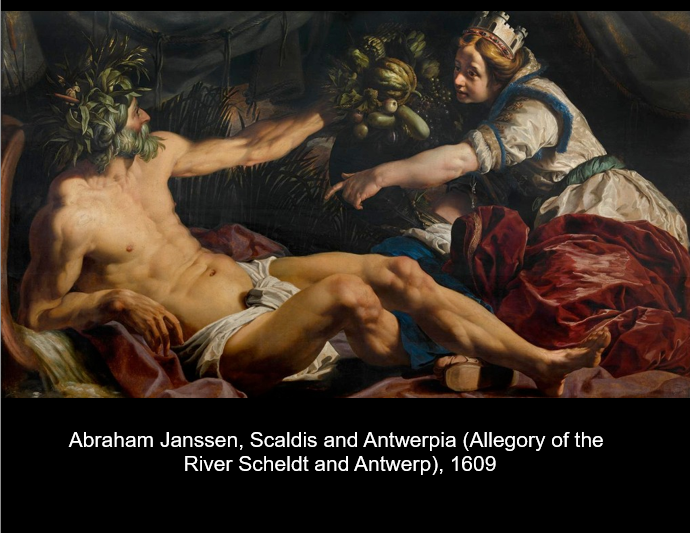
•The 3d and emphasis on space and low viewpoint is typical of Abe ^
•Flemish painter in Antwerp
•Very strong cultural style with figures very starkly modelled to enhance their figure
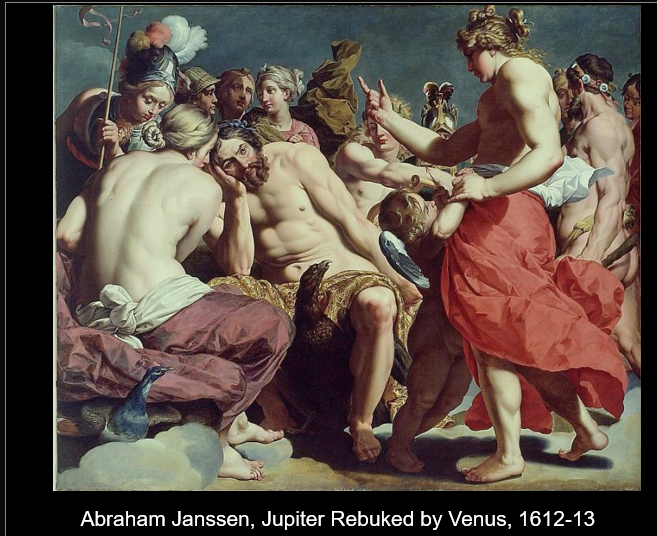
•Large, life-size, volumetric figures
•Much more reminiscent of more classist art in Italy
•Venus with cupid, trying to get Jupiter to do the right thing
•Really full bodied, solid 3d figures in the foreground
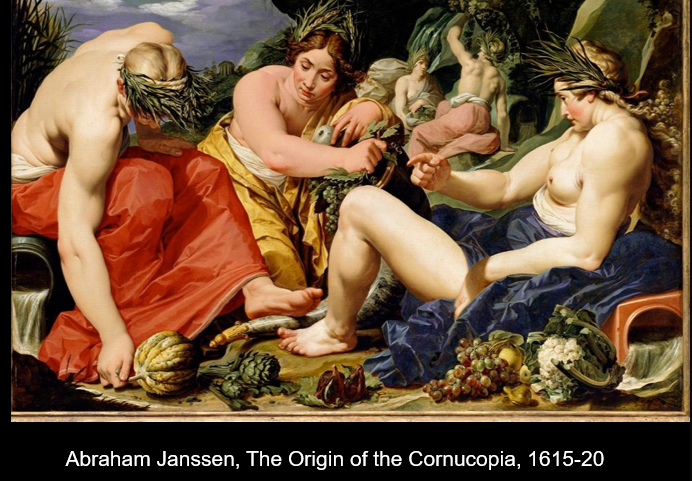
•Three river nymphs
•A symbol of overflowing abundance
•Very 3d, volumetric figures
•Low viewpoint! Again!
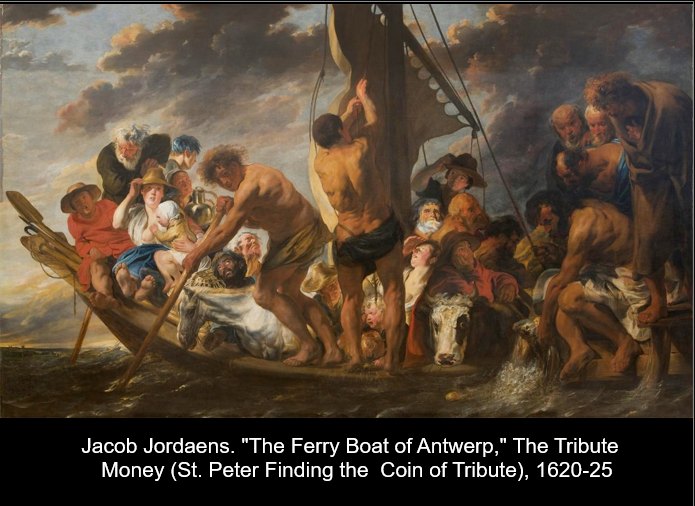
•The actual subject is off to the side, St. Peter finding a coin at the instruction of Christ, to pay tax
•The boat appears ready to tip over
•Element of humor, jam packed boat full of people and animals
•Jake likes to fill in areas with another head, like below the arms and between the legs
•Again! All of it right smack into the foreground!
•Everybody in motion, mouths open

•Big altarpiece
•Jammed with figures at a point with almost angular awkwardness
•Reminiscent of Rubens, but less space
•It seems that the horseman in the foreground is coming from Rubens, The Stroke of the Lance
•Lacks a feeling of breath
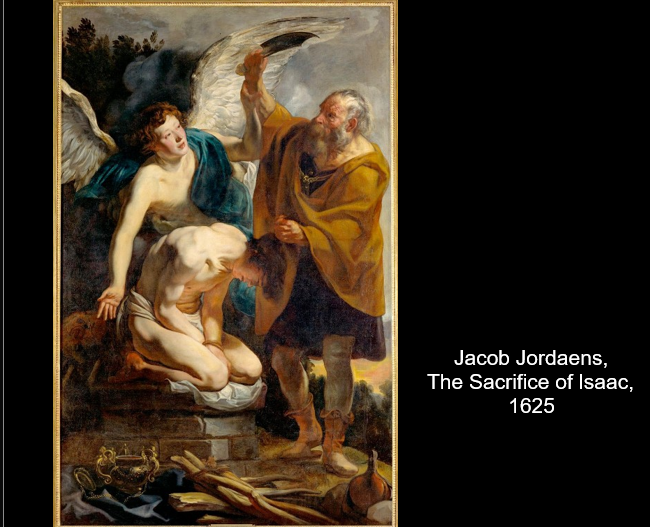
•Jake’s paintings become more formulaic
•A sense of shortcuts or stylizations
•Figures become more static, less drama
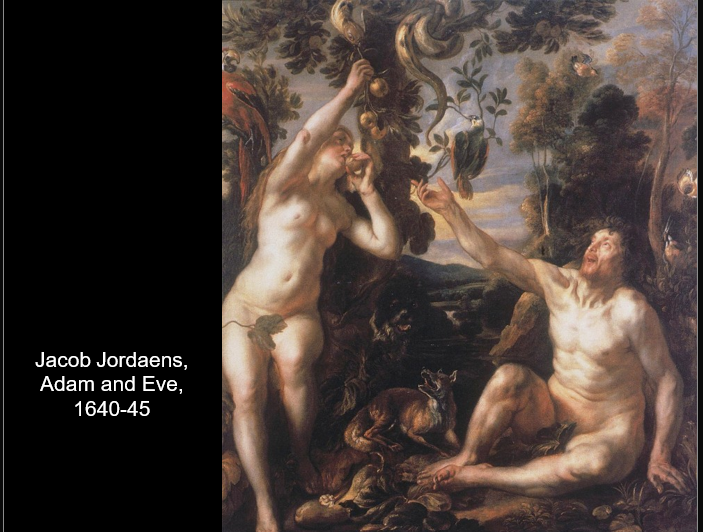
•After the death of Rubens and Van Dyck, seems less thoughtful
•This Adam and Eve derived from Rubens
•Fatter, heavier figures
•In no way a handsome Adam
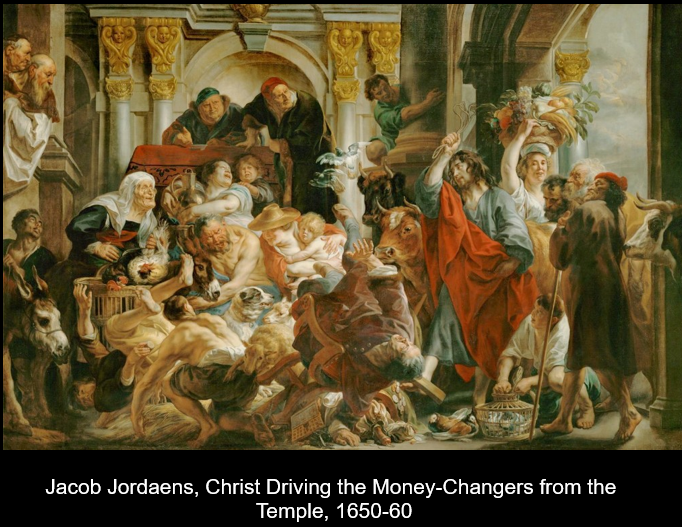
•As he got older, pronounced taste for spectacle, large imagery, full of movement, lots of people
•Figure of Christ coming into the temple where they are buying and selling animals to make blood sacrifices
•Figures seem to mount one on the other
•Man is tumbling right into our space
•Juxtaposition of humans and animals
•Temple officials on top, there for their cut of the profits
•Many emotions
•Maybe some humor there
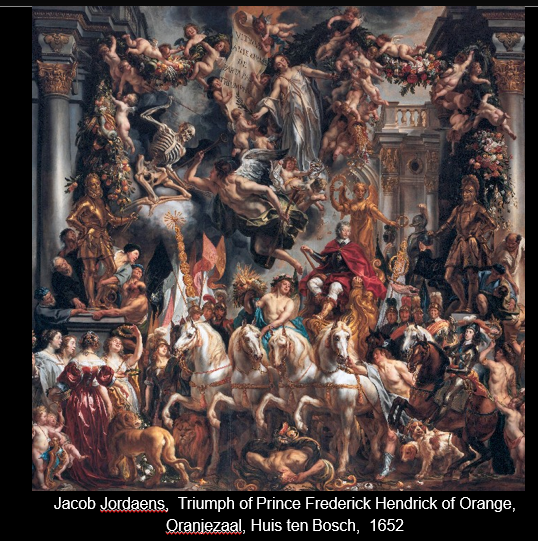
•Big painting
•Gigantic allegory, artist combining real figures and real events with made up things that stand for things and mythological figures
•We see this guy Fred in a chariot drawn by four white horses, straight out of Roman history
•Horses are trampling figures that represents trampling down discord and hate
•The son of Fred is there
•Up above there is a figure of fame, trumpet announcing the fame
•His ancestors are there, very elaborate allegory on a huge scale
•Not very common in the Dutch Republic
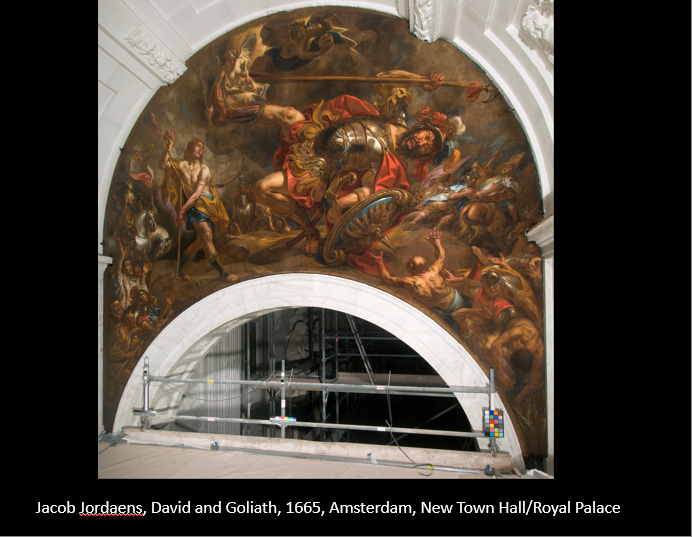
•Gigantic paintings for spaces above windows, lunettes
•David slaying goliath, seems to be almost coming into our space
•Very energized
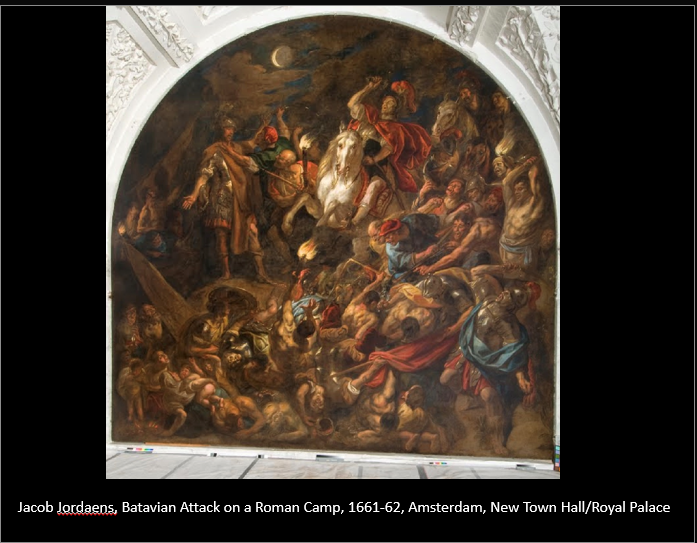
Attack by the Batavians on the Romans
Tremendous figures that seem to be tumbling all over each other
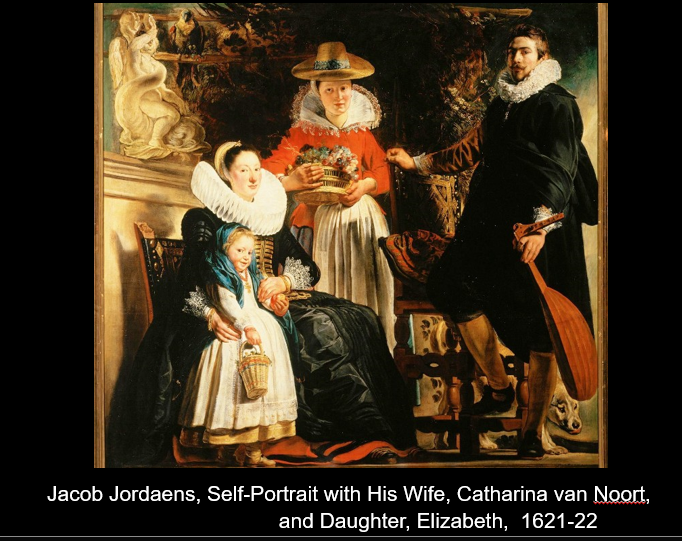
Produced a small number of portraits
This is with his wife sitting down and their daughter there
Jordaens has been serenading his family with a loot, idea of creating harmony through love
There is the servant there
The idea of the family in the love garden resided over by cupid, a parrot
Idealizing the family unit and turning it into something that has a brush with the sacred
Very low viewpoint again
A bit informal in that Jacob is on the wrong side but the light is still more complex on his face and he is more active still
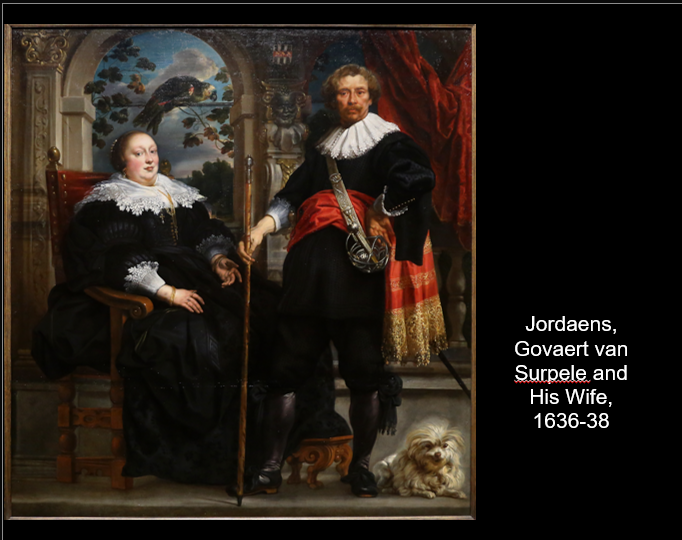
The man at the viewers right, otherwise follows the rules
Portrait of a man who was the captain of the city militia of Antwerp and he was a very prominent citizen, head of the clothmakers guild
We see the allusions of paradise by the parrot and the monumental architecture
Black was viewed as the only appropriate color and good taste
He has a sword, indication of his rank and his stature as a military man
There is an ODD quality: juxtaposition of him with a satyr mask
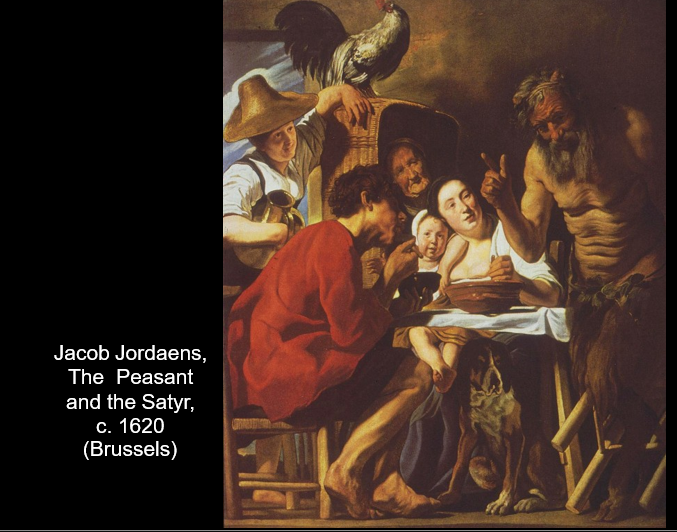
Jake is best known for fables, proverbs, local custom
The Satyr was disturbed because the man could blow both cold and warm air; you can’t be trusted
A scene that embodies a sort of peasant vitality
Meant to be sort of funny
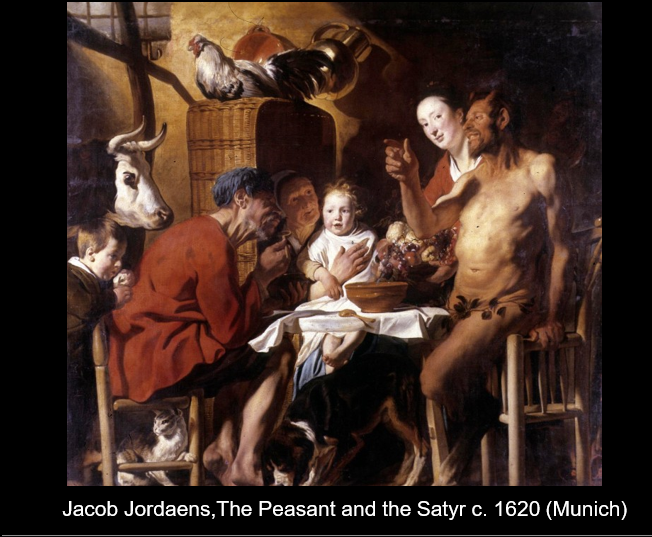
This is another version, alters the position of figures, adds figures, drops figures
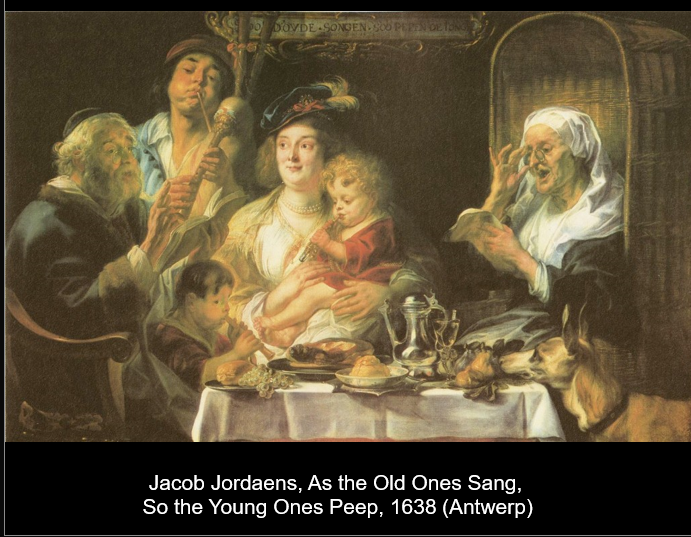
This is depicting a saying ^^
Reference to birds, teaching young ones to sing, children blowing on flutes
This is a popular proverb among the Dutch
A scene of the handing down of behavior from generation to generation
It is implied they are learning overindulgence, vice which isn’t good I guess
Bagpipe, cautionary tone, bagpipes were phallic at the time